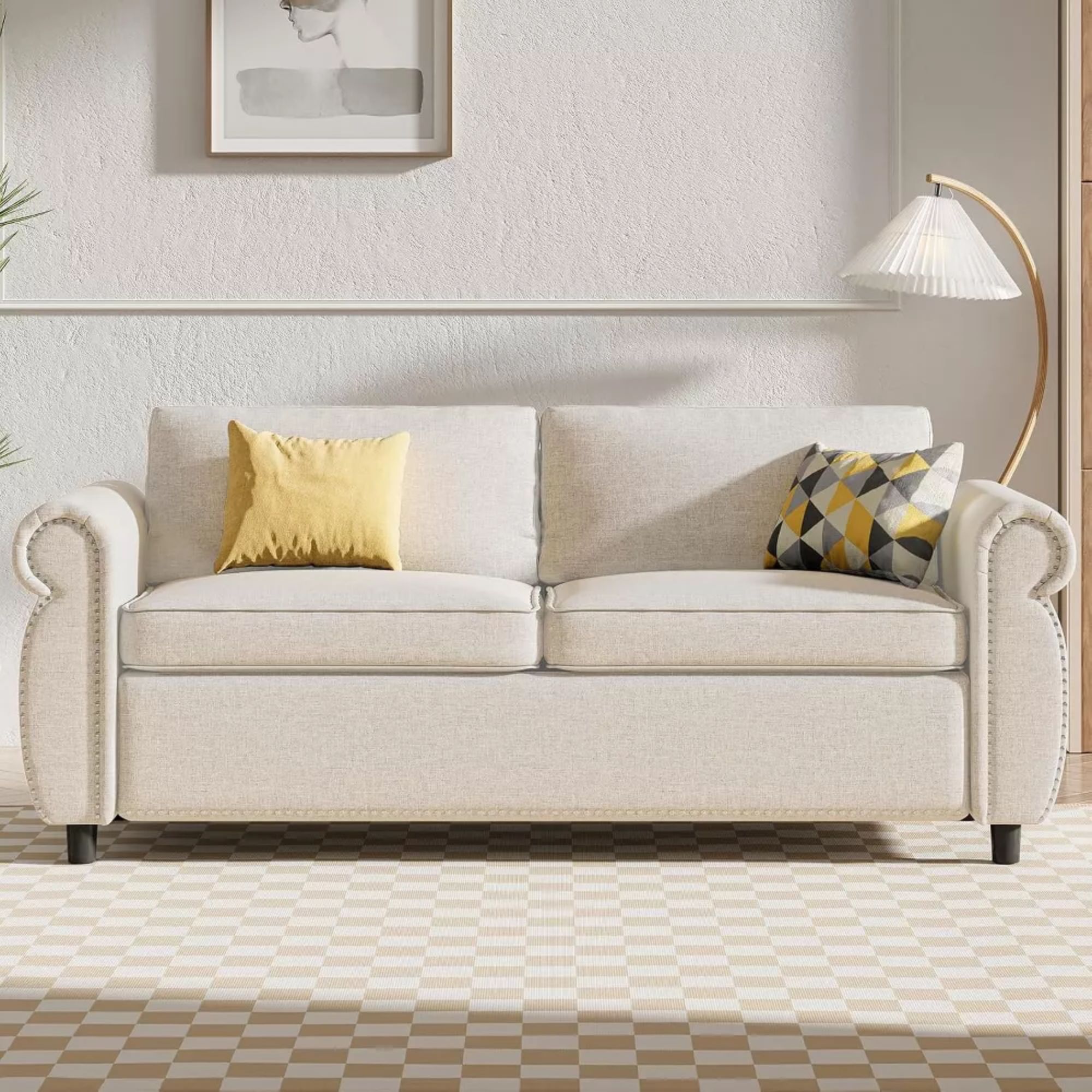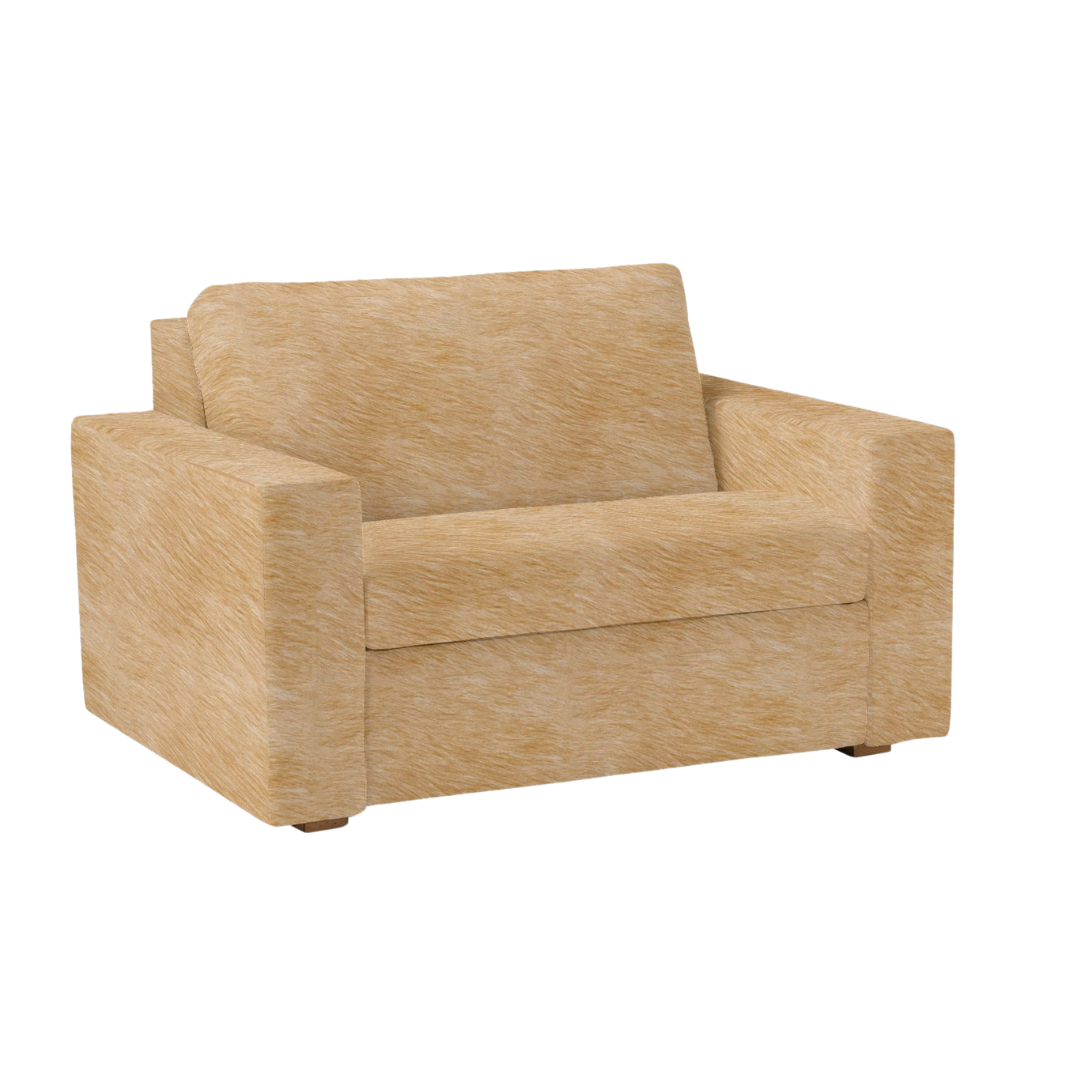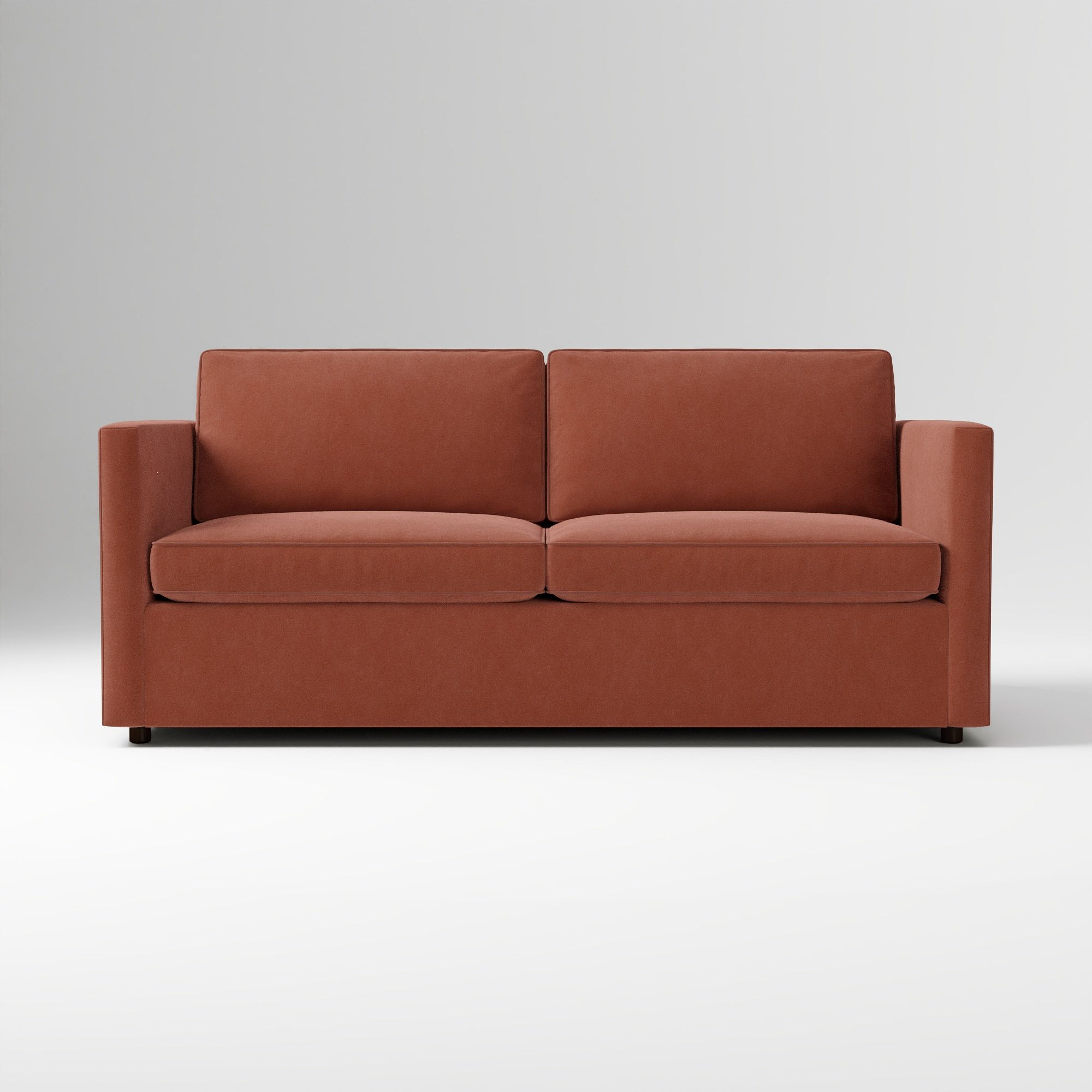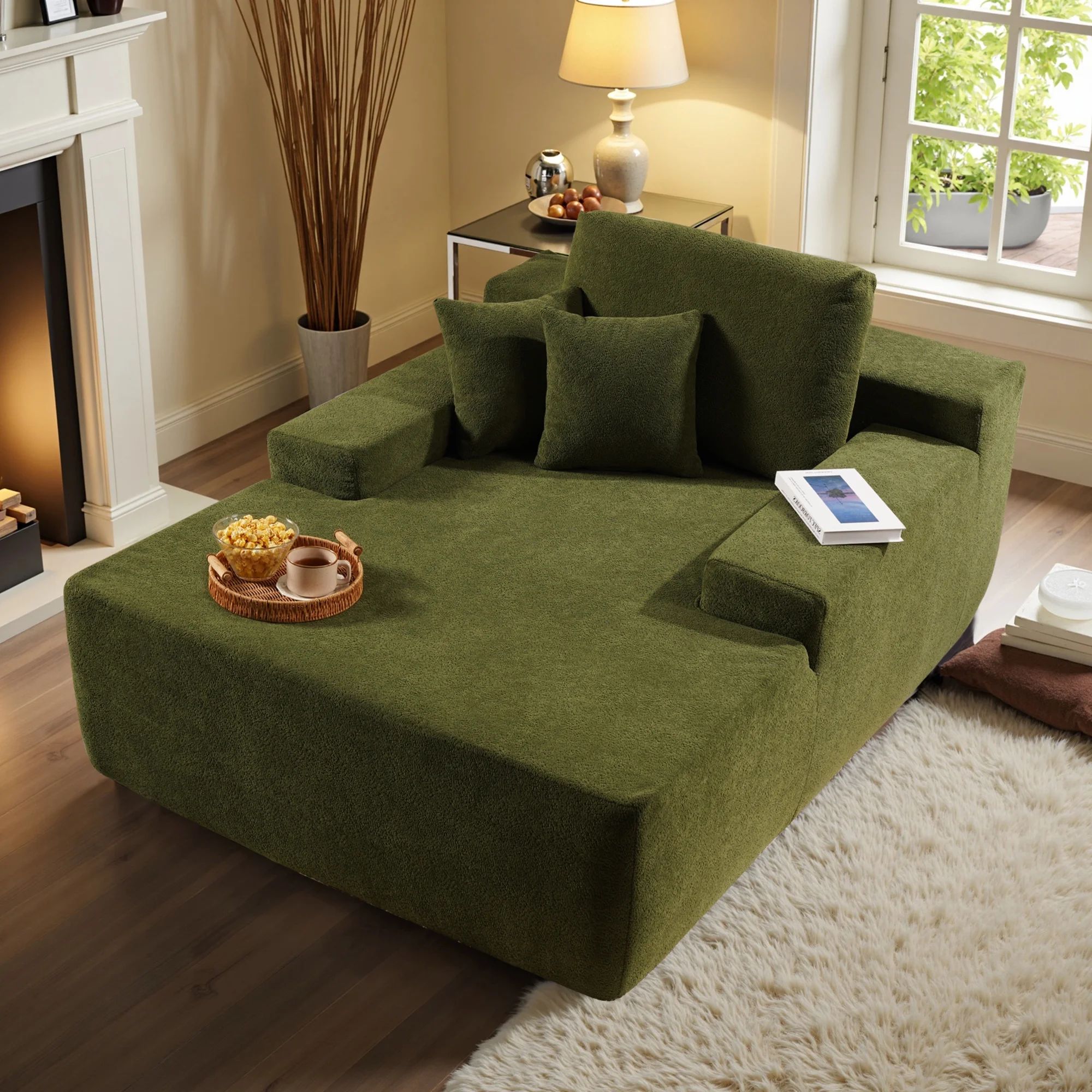Our Edit of the Chicest Sleeper Sofas You’ll Actually Be Proud to Offer Guests – These Are the Best Buys and Brands We Would Recommend to Friends
Here's everything you need to know to help you choose a sleeper sofa that is stylish yet doesn't feel like sleeping on a rock
Emilia Hitching

Few people grasp the urgency of space-saving furniture quite like New Yorkers. And because I live in Manhattan, I’ve developed a personal doctrine around sleeper sofas, starting with rule number one: they cannot look like sleeper sofas. Only really chic pieces that could also qualify as the best couches apply. And while they’re not technically beds, as someone who routinely ends up sleeping on them during family trips, I can attest that they need to feel just as puffy as whatever mattress you left behind.
Whether you’re outfitting a guest bedroom, making your living room do double duty, or hosting without a guest room at all, the best sleeper sofa has to nail four things: aesthetics, practicality, quality, and price. So I took all of the above into account to curate the sleeper sofa guide I wish I had years ago, pulling from expert intel, customer reviews, personal experience, and my own Style Editor’s eye.
I haven’t tested every sleeper personally, but I have bought from most of these brands – think Wayfair, Target, Pottery Barn – and spent more hours than I’ll admit poking around showrooms, cross-checking mattress types, upholstery options, and the brutally honest reviews only the internet can provide.
Ahead, a tightly edited, expert-informed guide to the best places to buy sleeper sofas – plus everything you need to know to feel confident investing in a piece that looks great by day and sleeps surprisingly well by night.
Best Sleeper Sofa Shortlist
Great-looking sleeper sofas seem like an oxymoron, but I promise that they do exist. With Black Friday home deals looming, these are the retailers I’d hit first if I had guests showing up next week.
- Amazon: Not the chicest, not the most high-end, but fast shipping, sub-$500 price points, perennially BF-level discounts, and countless candid reviews make it surprisingly easy to uncover a gem.
- Anthropologie: Think House-of-Hackney-adjacent florals and candy-pink trundles, many of which are currently marked down for Black Friday sales.
- Crate & Barrel: If your sleeper will anchor the room or accommodate frequent guests, their clean-lined leather models are worth the splurge (and even better with the up to 50% sales happening for Black Friday).
- Quince: This newcomer is doing what it does best: high-design sleepers at refreshingly sane prices, soon to be even sharper with its Black Friday markdowns.
- Target: No reinvention here, just classic silhouettes upgraded with comfort-first perks like memory foam.
- Walmart: Convertible couches that swing, contemporary or traditional, always with an everyday-low-price ethos, now even lower thanks to the Black Friday sales.
- Wayfair: If you can dream it, it’s here. Shop every sleeper size, style, fabric, and mechanism imaginable with deep Black Friday discounts and the brutally honest reviews to match.
My Top Sleeper Sofa Selections
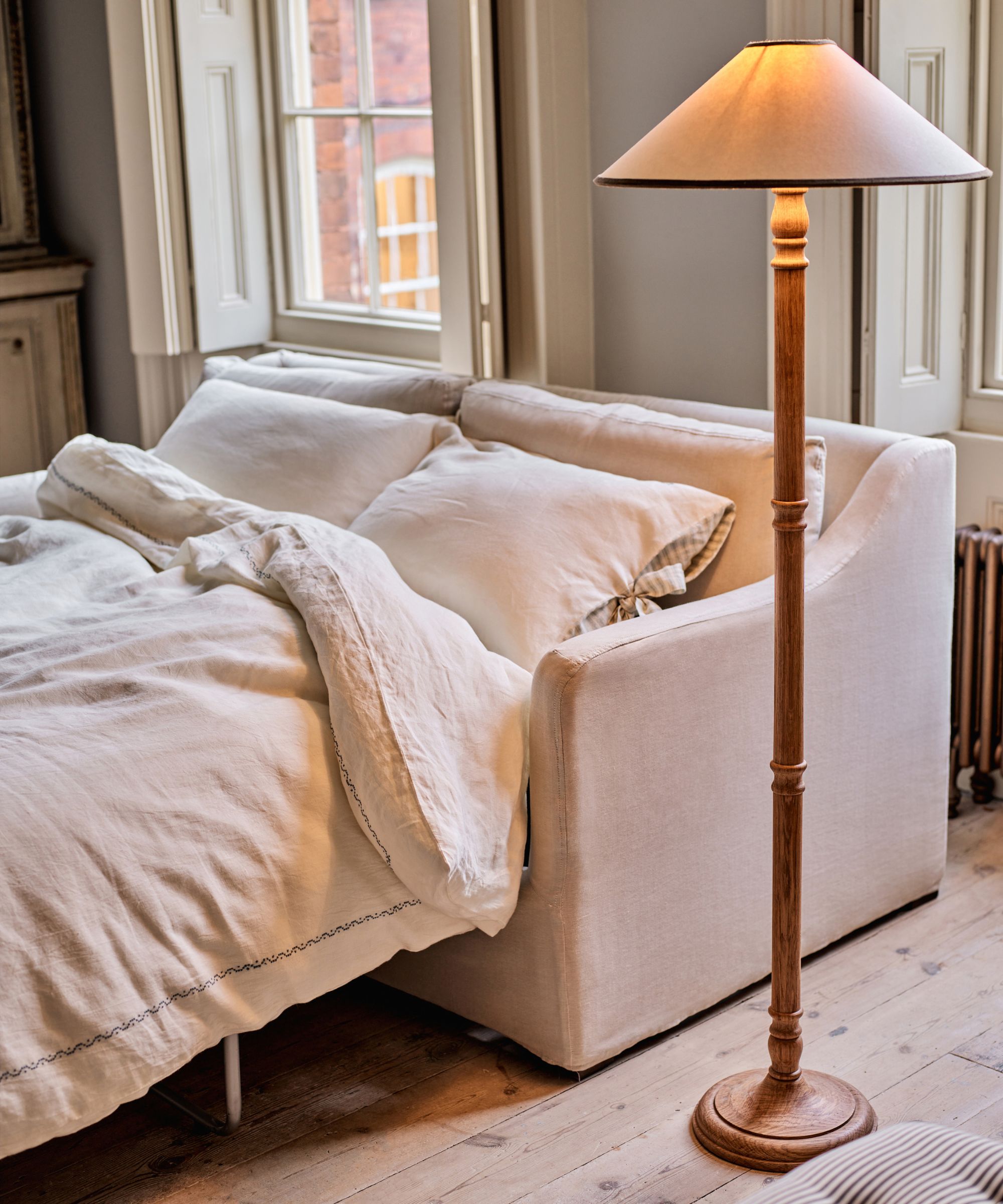
When trying to narrow down my top sleeper sofa picks, shopper reviews were of top priority. I combed through hundreds (if not thousands) of online reviews to find three models that consistently earn high marks for comfort, style, ease of use (you don't want to enter into a wrestling match in order to fold it down), and customer satisfaction.
With a mix of price points and styles for every kind of shopper, these have earned their top spot thanks to their dependable design and happy shoppers. If you're looking for a sleeper sofa that matches style for comfort, these are the crowd-pleasers worth bookmarking.
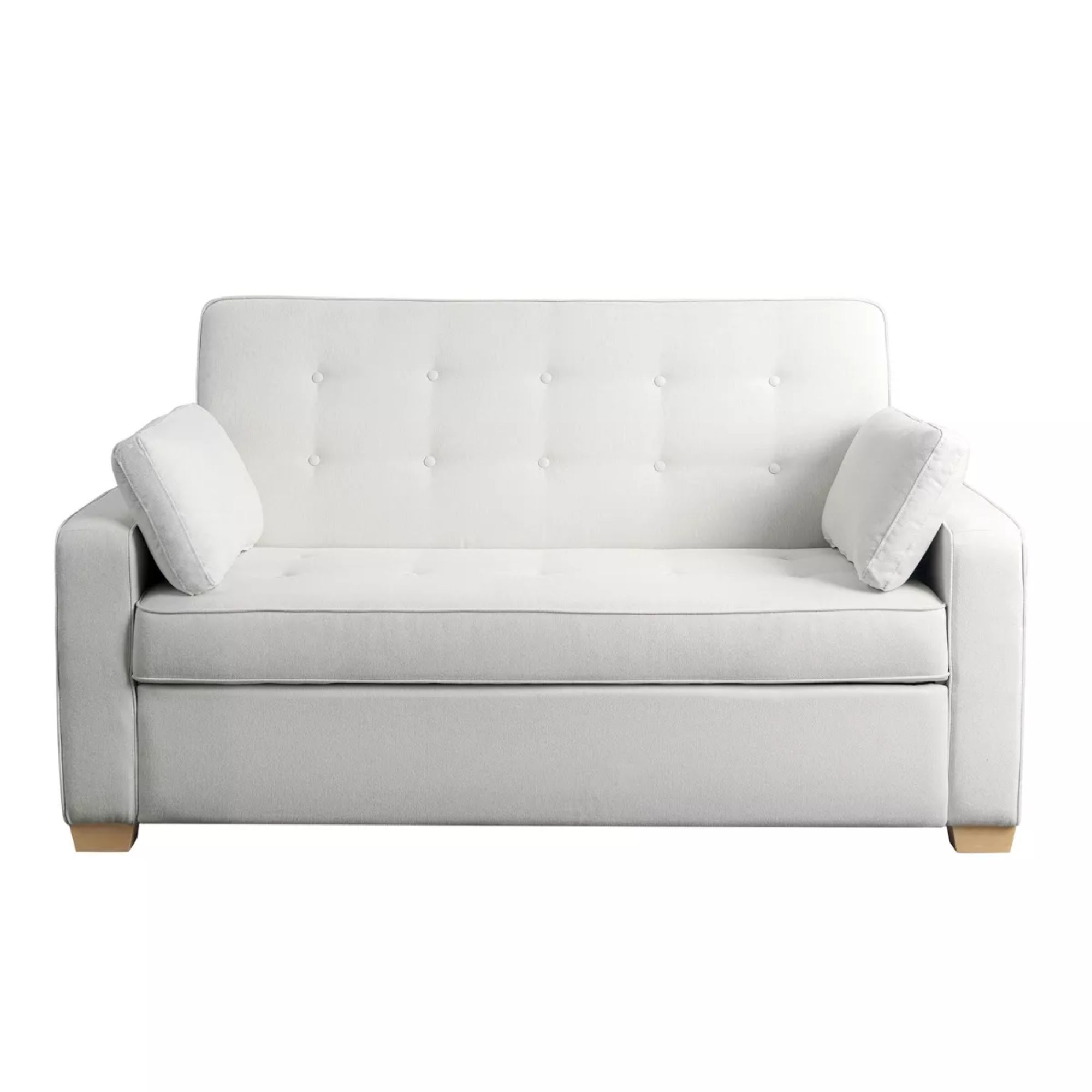
With only 5* reviews, the ever-popular Andrea sleeper by Serta uses smart engineering for the three functions: sofa, lounger, and queen-size bed. Making it perfect for a den or a versatile home office. The Andrea comes with Serta's patented Finger Guard Protection with click & lock technology to avoid injury too.
One reviewer says: 'It's better than my bed! Also converts into a full queen-size bed, and let me just say it's the most comfortable bed I've slept on. I tend to fall asleep on it every time I lay down on it.' Which has to be thanks to the high-density foam cushions and extra (included) throw pillows. Another reviewer adds: 'I love how convenient it is. I love how in three seconds you can go from a couch to queen bed. It’s super comfortable.' This is a really great, affordable all-rounder.
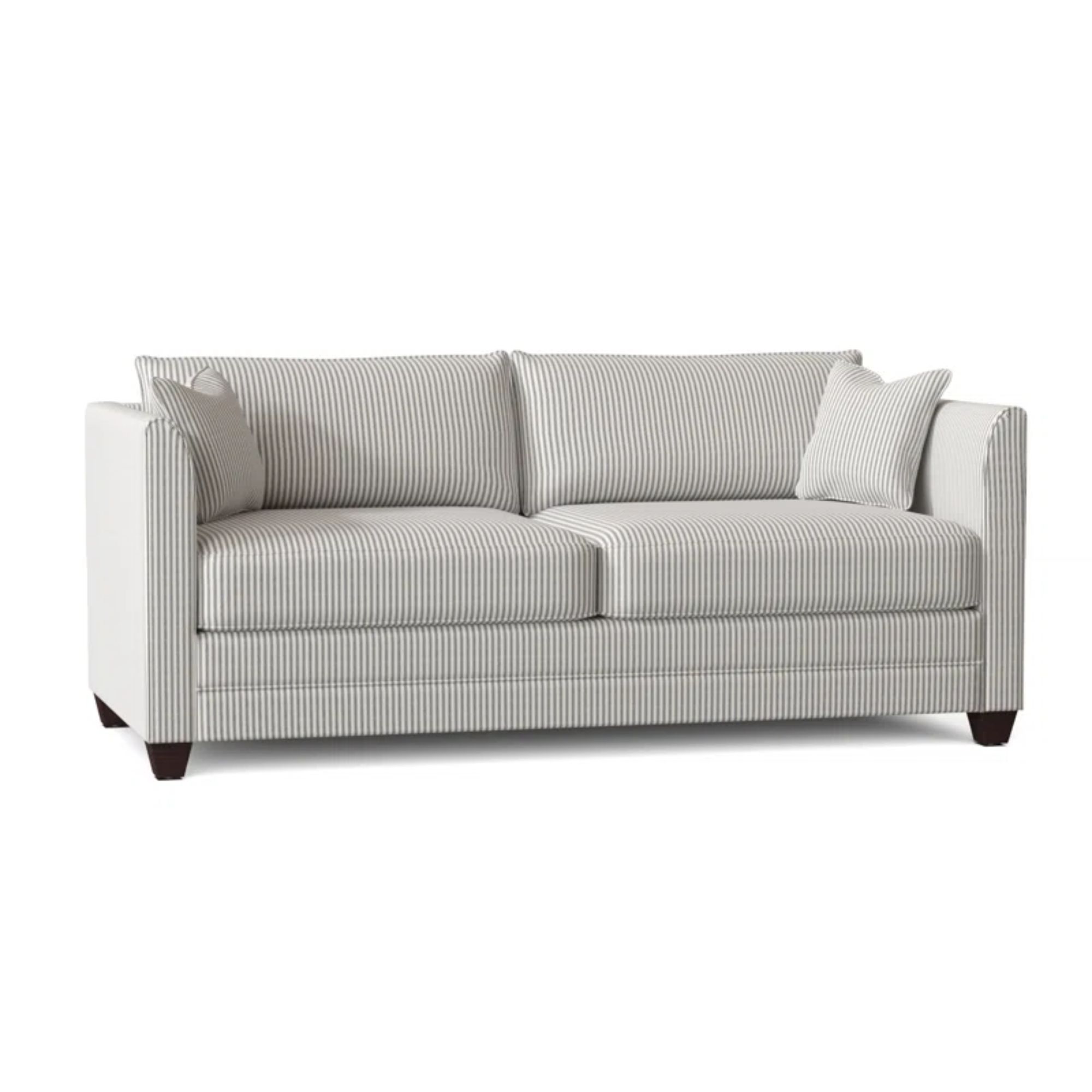
One of the top-rated sleepers on Wayfair (1,671 reviews – with the majority being 5*), the Kodie sofa is made by Wayfair's own Joss & Main and boasts one of the most customizable and stylish exteriors of all the sleepers I've researched. With 20 fabrics to choose from, including this Cruise Adrift Woven Stripe seen above, this is the first sleeper sofa I've found available in a coastal style stripe.
Each piece is made to order in the USA using a solid and engineered wood frame with walnut-finished legs and folds out to a comfortable queen-sized bed. On the mattress, reviewers add that it is great for guests, but they have added a mattress topper for longer stays. 'Very comfortable to sit on, and the material is soft. Decent pull-out mattress, but for a long-term visitor you might want to add a topper to it. Easy to pull out into a queen sleeper and very nice looking couch,' says one reviewer. So do bear that in mind if you're thinking of buying for more frequent use.
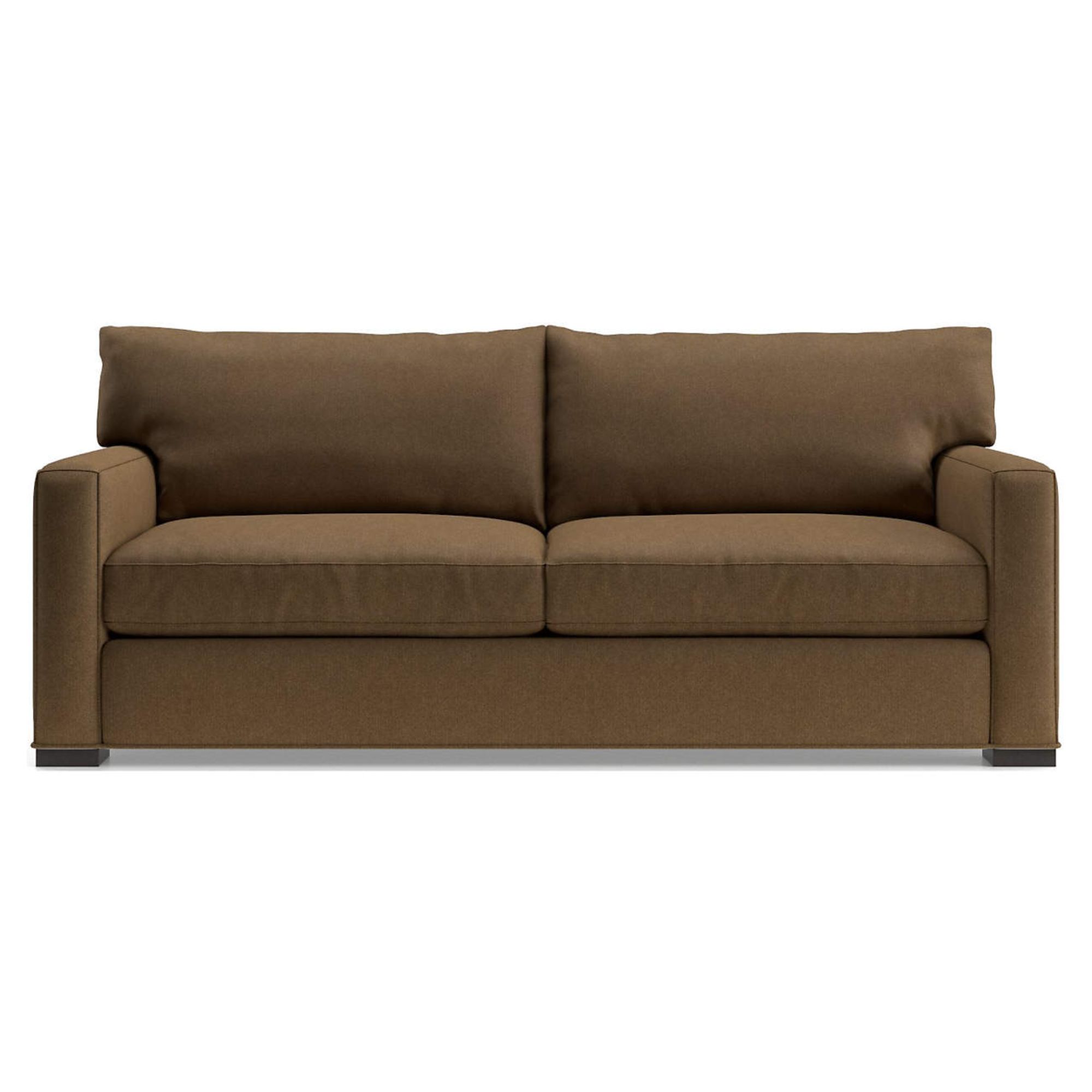
As the top-rated sofa on Crate & Barrel, the Axis collection of couches is the stuff of legends – or a 'Crate Icon' as the website calls it. While the Axis comes in many non-sleeper forms, you can also choose from five convertible sofa bed options, including a Queen Chaise Lounger for versatile comfort.
Most of the 2,852 reviews rave about the durability of the fabrics (of which there are 225 to choose from), including pet owners who can attest to the pet-friendly and easy-cleaning capabilities. The pull-out mattress has a genius tilt-up headrest for late-night reading or TV viewing, and you can opt for a standard type or an air mattress that customers love.
'I recently purchased this sleeper couch and I'm absolutely thrilled with it! The fabric is excellent quality, soft, and comfortable. The design is stylish and modern, and it looks great in my living room,' raves one reviewer. 'The sleeper function is easy to use, and the mattress is surprisingly comfortable. I've had guests sleep on it and they've all reported a great night's sleep.'
The Best Places to Buy a Sleeper Sofa

Whether your aesthetic leans traditional or modern, there’s a sleeper out there that can seamlessly integrate with your style while still offering a comfortable night's sleep for family and friends. Keep reading to explore our top picks for where to buy sleeper sofas – plus our favorite models from each brand.
1. Pottery Barn
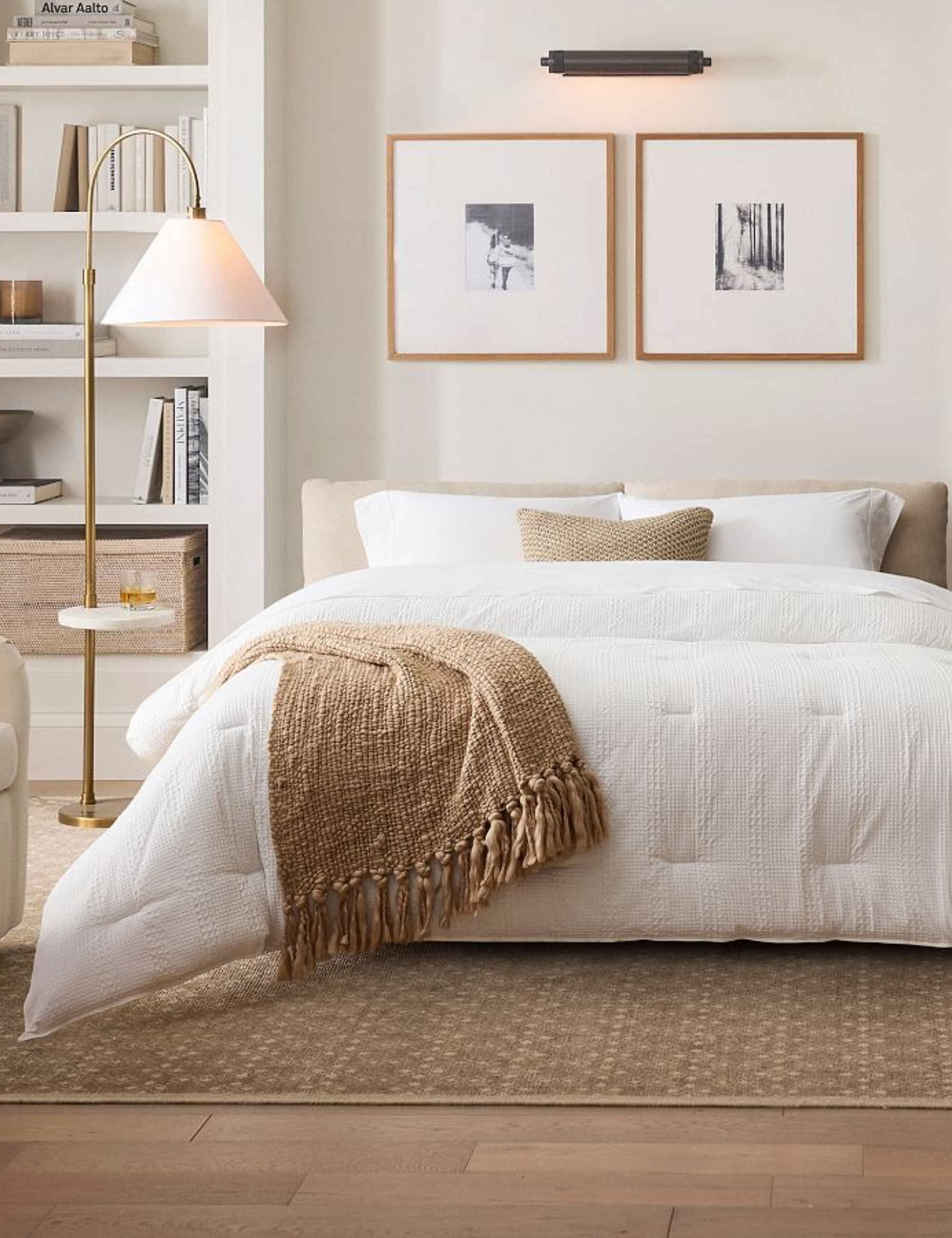
Best for: extra plush couch cushions and versatile options
Pricing: $$-$$$$
The best thing about shopping for sleeper sofas at Pottery Barn is their handy rating system. On each item, if you scroll down a little, you'll find their 'How It Sits' rating which gives you a sliding scale on the seat depth, seat height, seat softness, and overall sit (which discusses how relaxed vs upright it is). This then means you can get a really good idea of all the crucial features of a couch while shopping online – a hard thing to achieve.
Some of the best sleeper sofas can cost upwards of $5,000. Though most of the time, you get what you pay for, you can find quality pieces at lower prices at Pottery Barn. There are slipcovered sleeper sofas for quick and convenient cleaning, as well as Chesterfield-style sofas with dramatic deep tufting, and plenty of custom fabric choices, too.
Typically, their pieces come fully assembled, you can select from a standard flat delivery or white glove delivery, and returns of eligible items can be made within 30 days of receiving.
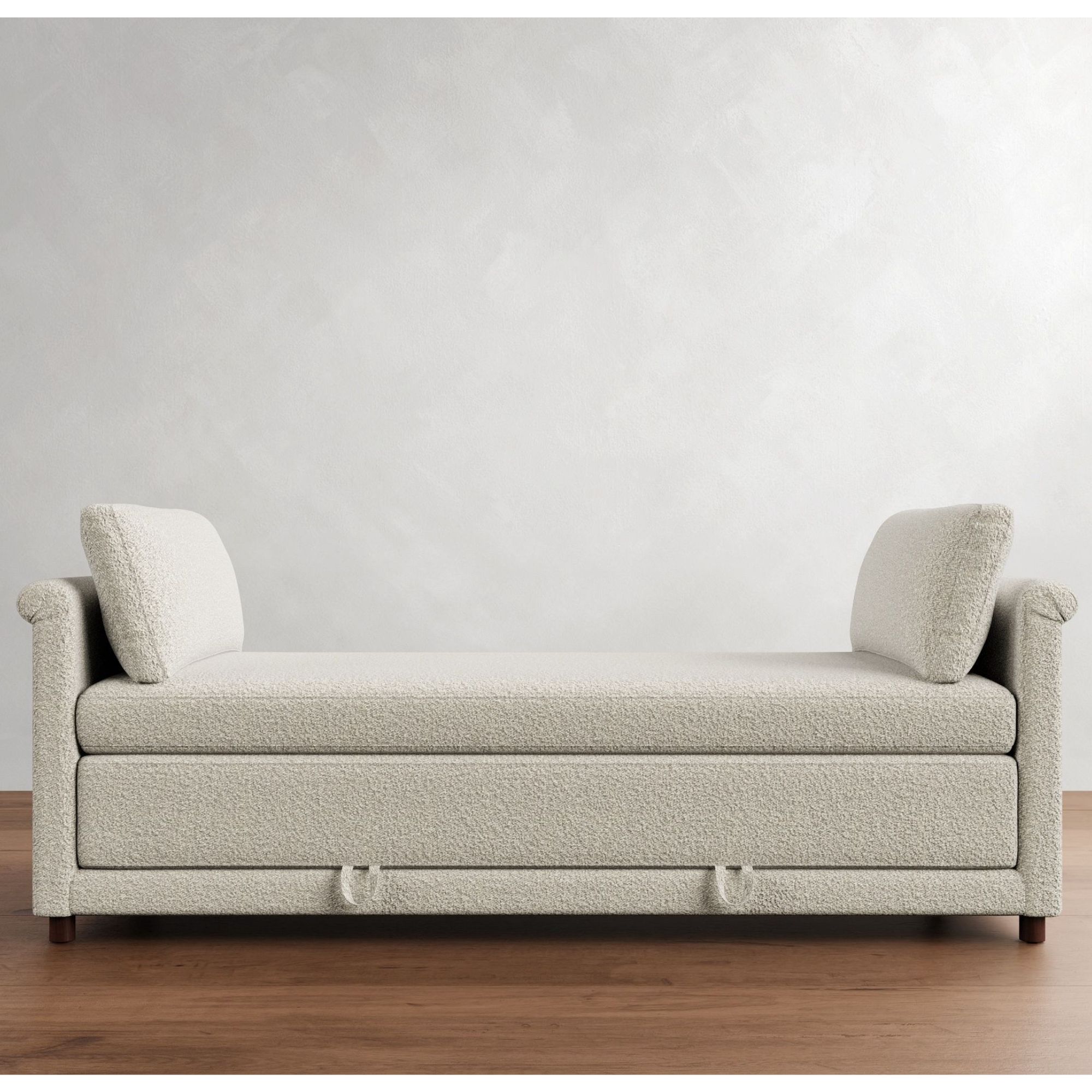
Dimensions: 87.5" w x 35" d x 30.5" h
For a less standard option, this daybed works perfectly if you're looking to maintain a contemporary, clean style or are looking for a multi-functional piece for a small space. Pull the base off the frame to create one queen-size bed or two twins.
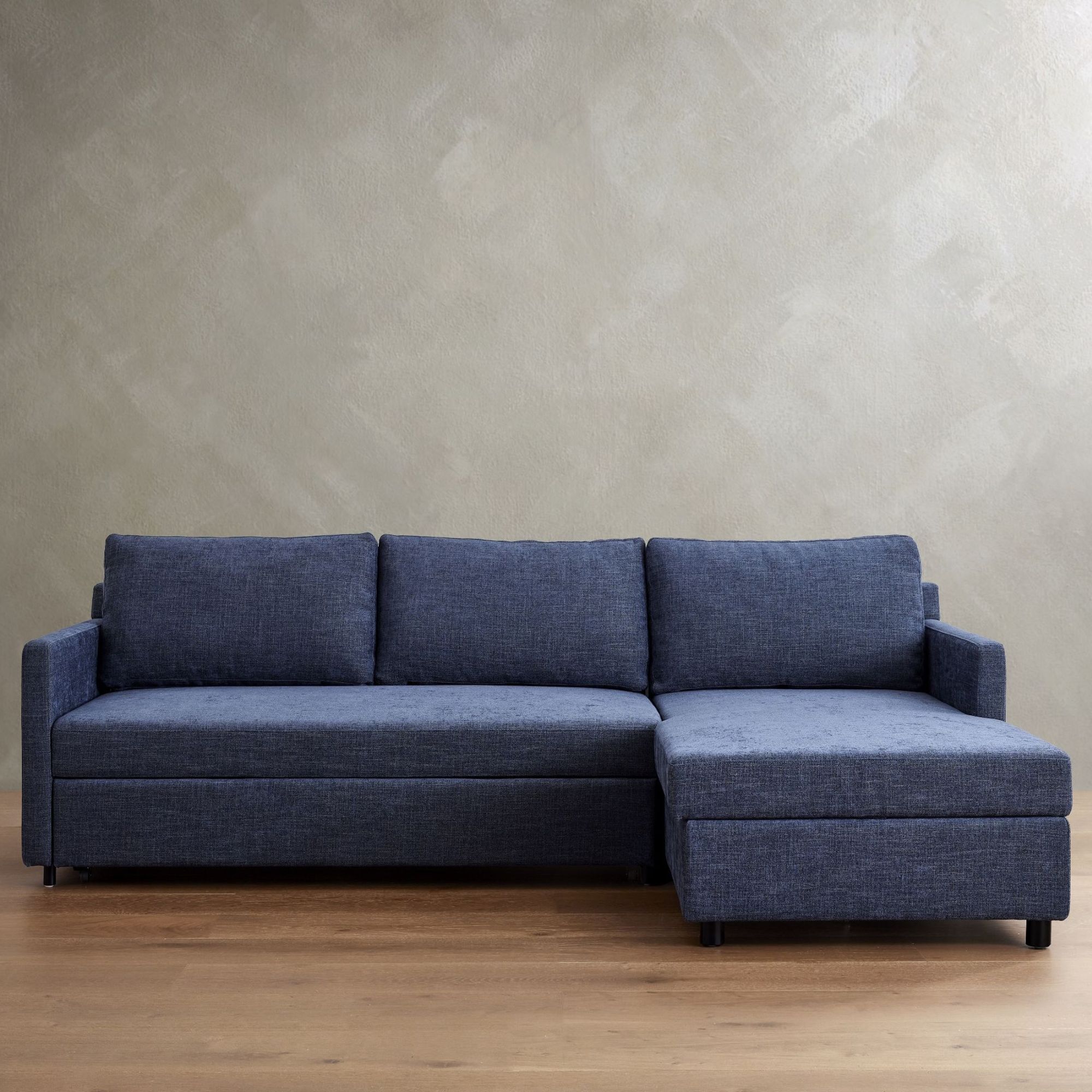
Dimensions: 99" w x 63" d x 36.5" d x 33" h
The Pacifica collection has many different sizes and styles, from two-seaters to this larger chaise sectional, so you can be sure to find a sleeper sofa that best fits your needs. It is compact with a slender profile yet has deep, sink-in cushions.
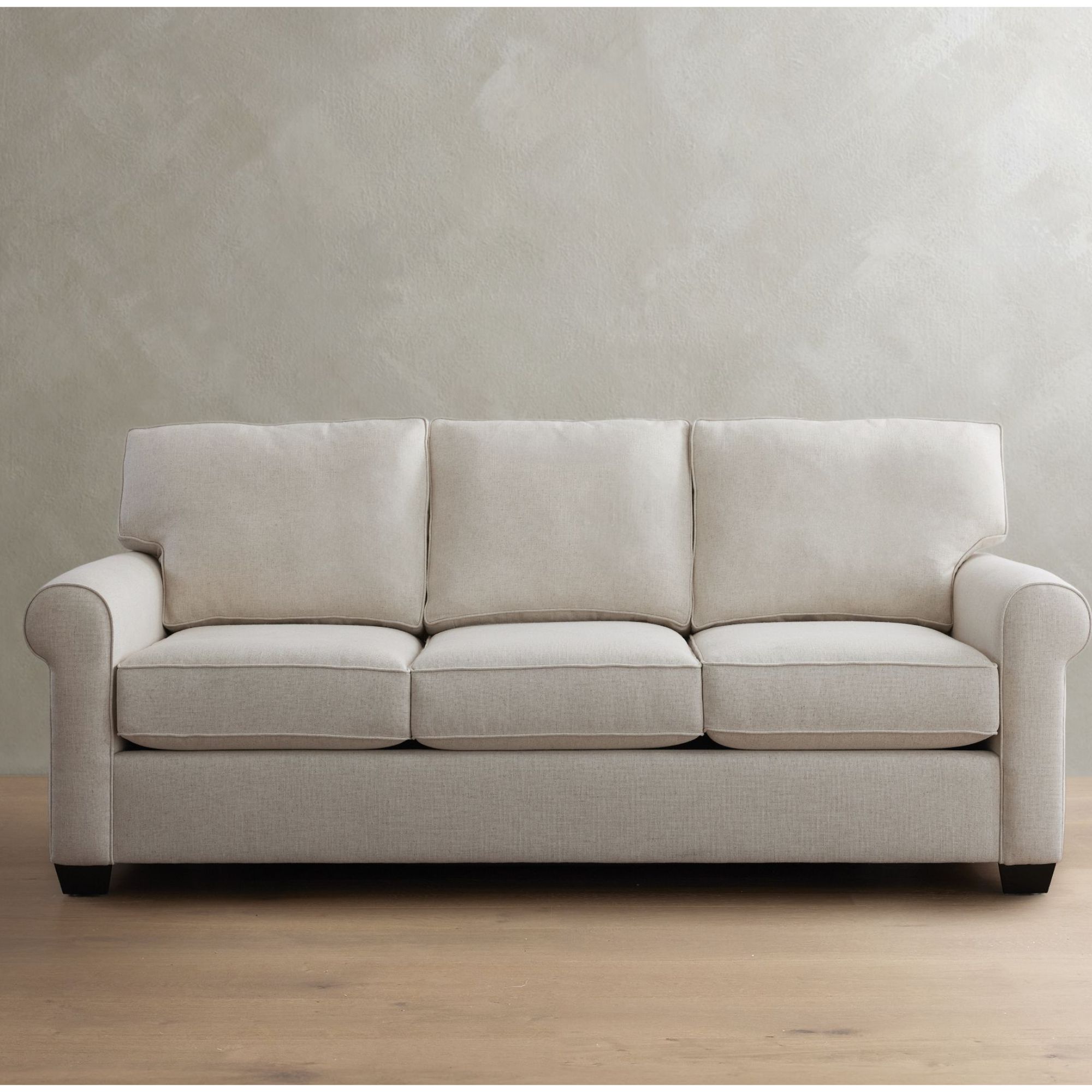
Dimensions: 87" w x 39" d x 37" h
Find another compact option in the Buchanan roll-arm sofa. The best part of this sleeper sofa is the memory foam mattress with enhanced elasticity for optimum comfort and a gel that wicks away body heat for a cool sleep.
2. Wayfair
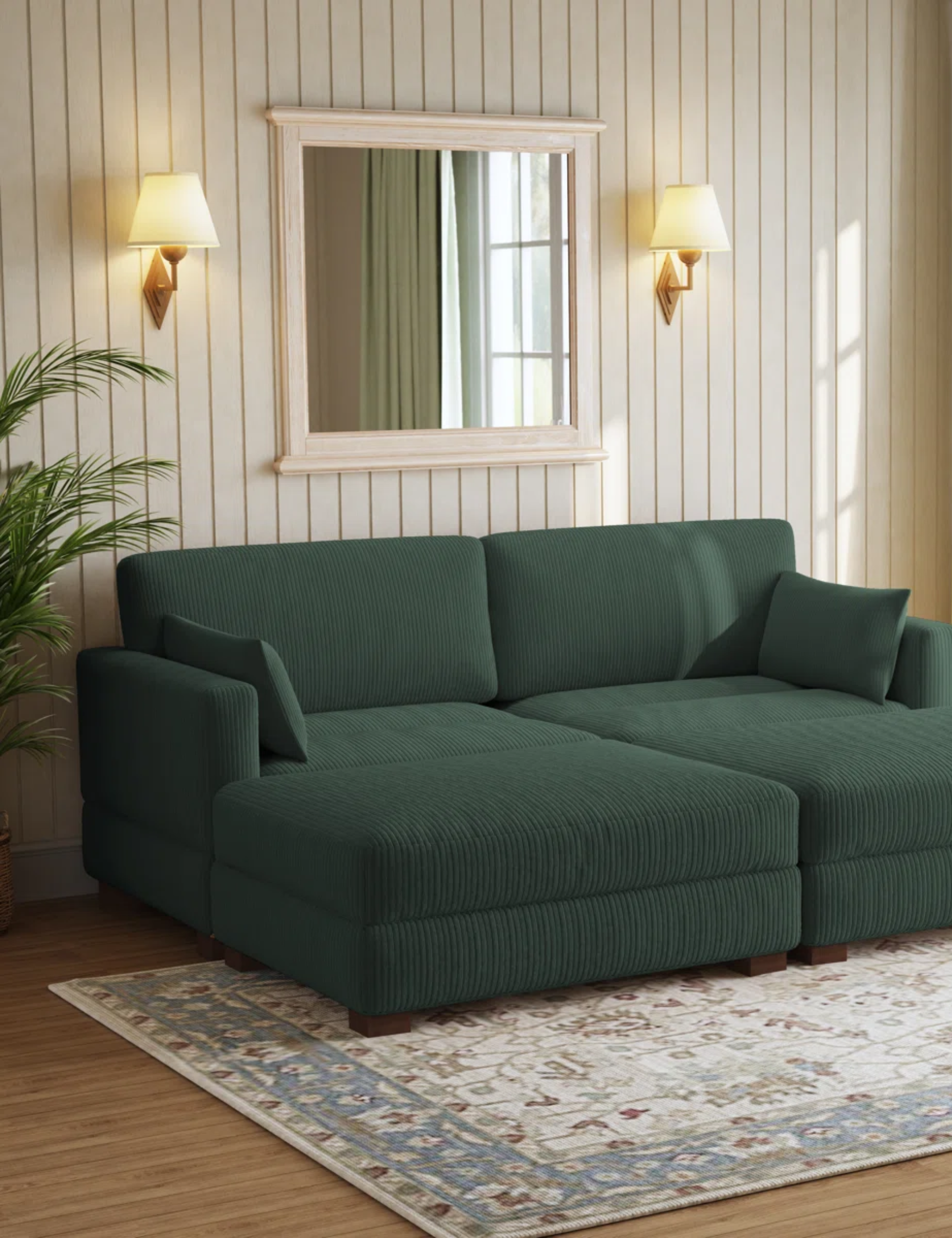
Best for: searching by customer reviews
Pricing: $-$$
If you're budget-conscious but of course still want a really good purchase, Wayfair is the destination for you. Sleeper sofas at Wayfair are typically hundreds of dollars (if not thousands) cheaper than elsewhere, and they allow you to opt for free white glove delivery so you can leave things to the professionals.
The best bit? You can filter by top customer ratings, so you can be sure that the couch you order has been tried and tested by lots of other real people in real homes. And as you may know, Wayfair carries a vast range of brands, including their home brands Birch Lane and Joss & Main, as well as mattress brands like Serta, which have ventured into sleep-worthy sleepers.
Sure, you can likely find better fabrications or more stylish shapes elsewhere, but for bang for your buck, Wayfair is it. Plus, you can always rely on the Wayfair sale for some even bigger bargains.
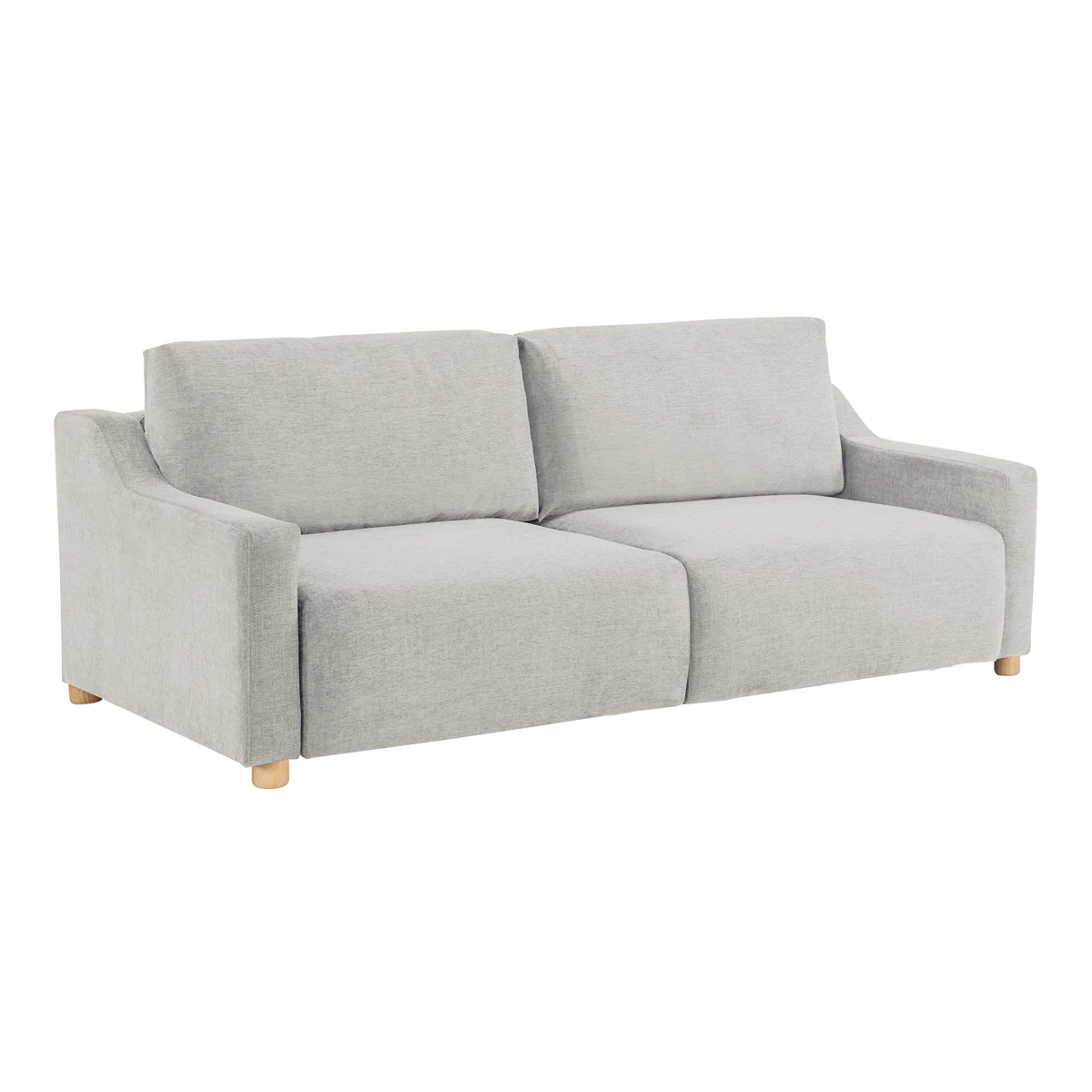
Dimensions: 34.3'' h x 90.2'' w x 42.9'' d
With a cloud-like, plump pillow back, the Gabi by Serta sleeper sofa is space-saving while remaining stylish and extremely comfy – if you listen to the 62 5* reviews. It is also stain-resistant and on a DreamGlide™ mechanism.

Dimensions: 40'' h x 83'' w x 38'' d
With 90 fabric options, including this traditional stripe, this slipcovered sleeper sofa lets you bring a customized, classic style to your room. Made in the USA, it has 272 5* reviews and no assembly is required.
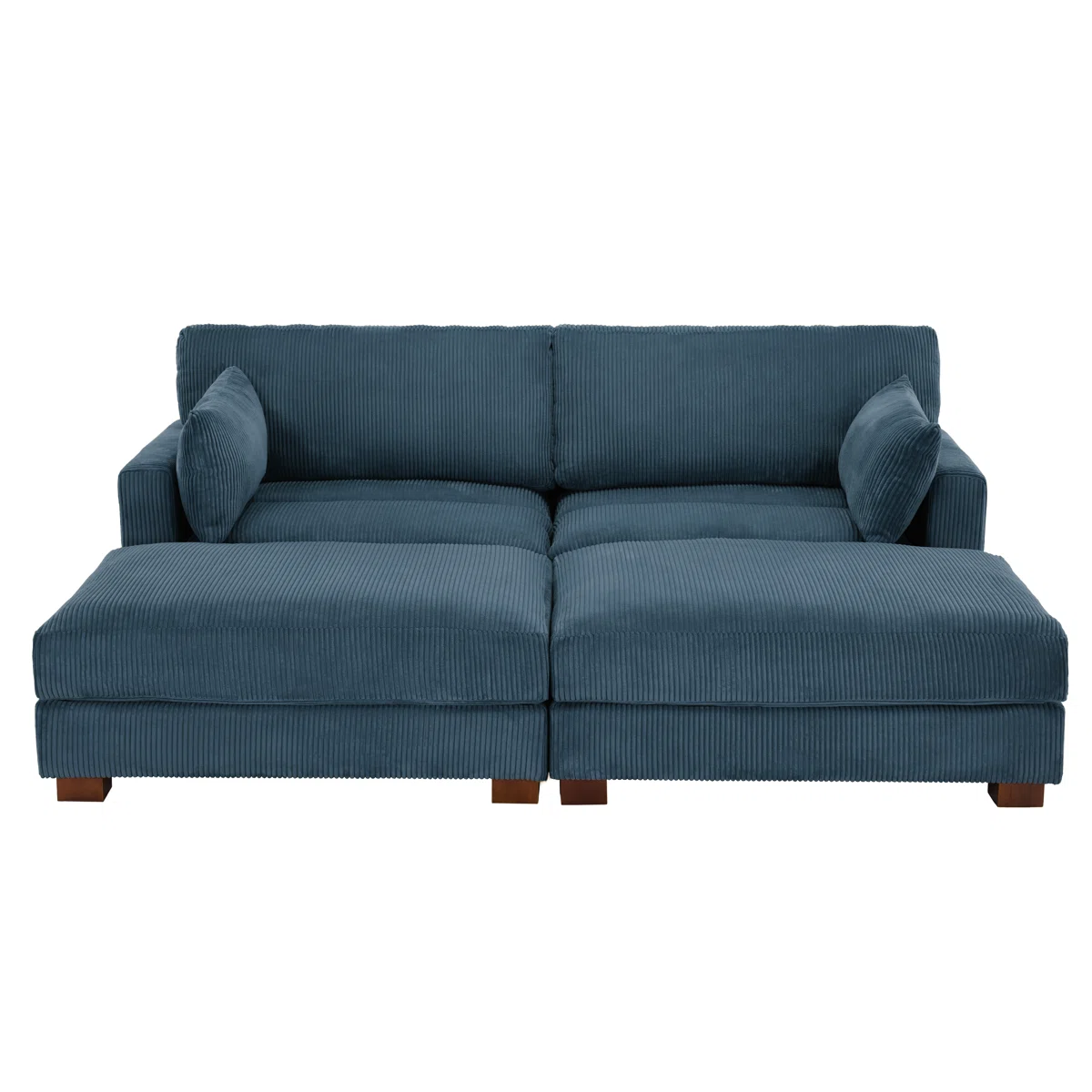
Dimensions: 35'' h x 90'' w x 57.5'' d
This Corduroy couch is marked as Wayfair Verified, which means it has been vetted and voted as 'loved' by the Wayfair team. And the reviews speak for themselves with 2631 5* reviews. Designed to seat two as a couch, it converts into a twin-sized bed that's just right for overnight guests.
3. Target
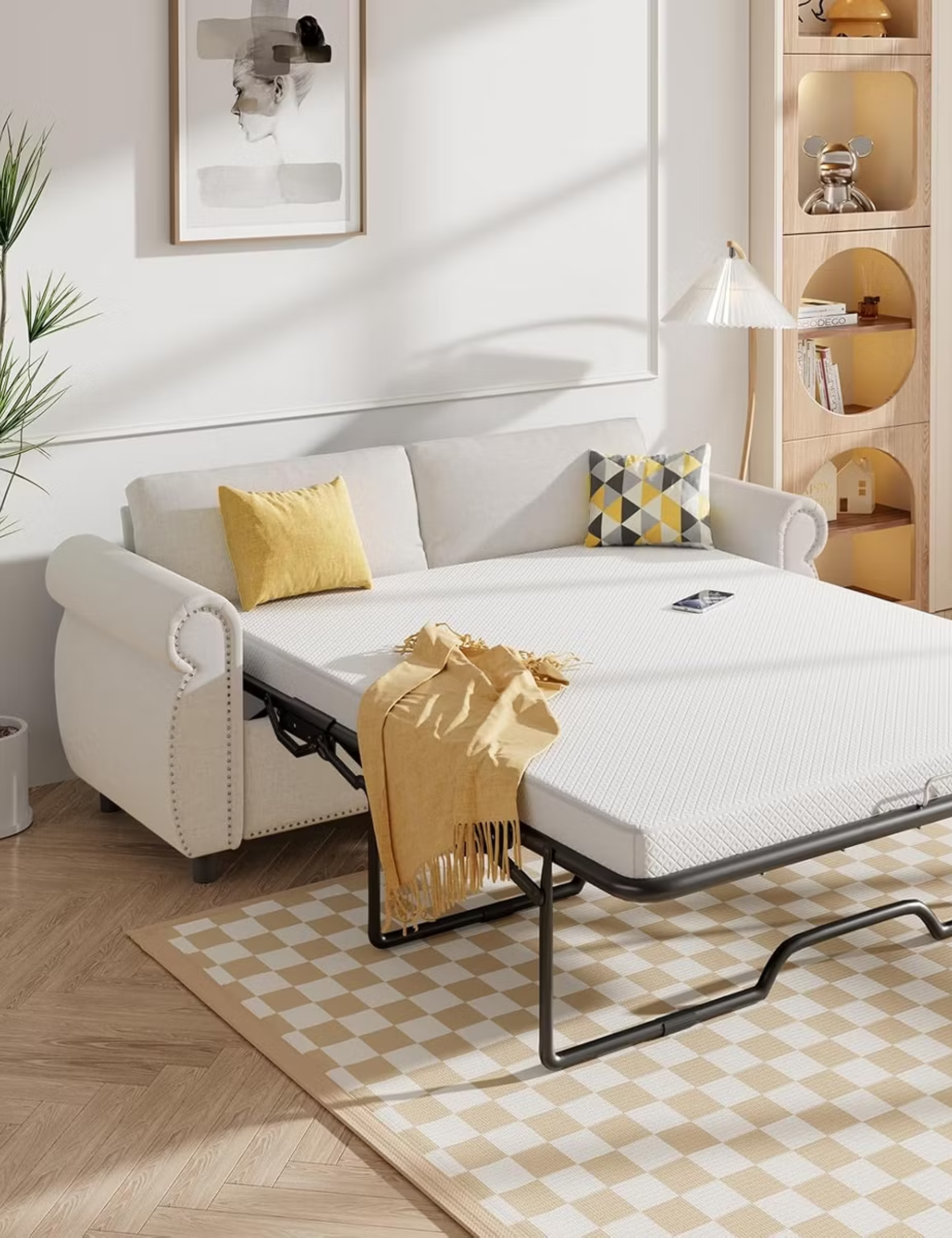
Best for: affordable yet highly-rated finds
Pricing: $-$$
Don't be fooled by the accessible prices at Target, these aren't cheap and cheerful products. In fact, far from it. I've seen some of the most glowing reviews I've come across on Target, and it's all thanks to solid construction, quick and easy delivery, and a range that fits your individual needs: from convertible armchairs to compact loveseats and pet-friendly PU fabrications.
Sure, they might not be the most design-led or luxurious options around but for a sleeper sofa that is used for extra guests on rare occasions, there are some really great couches to be found here. Be sure to filter by guest rating for the most-loved pieces.
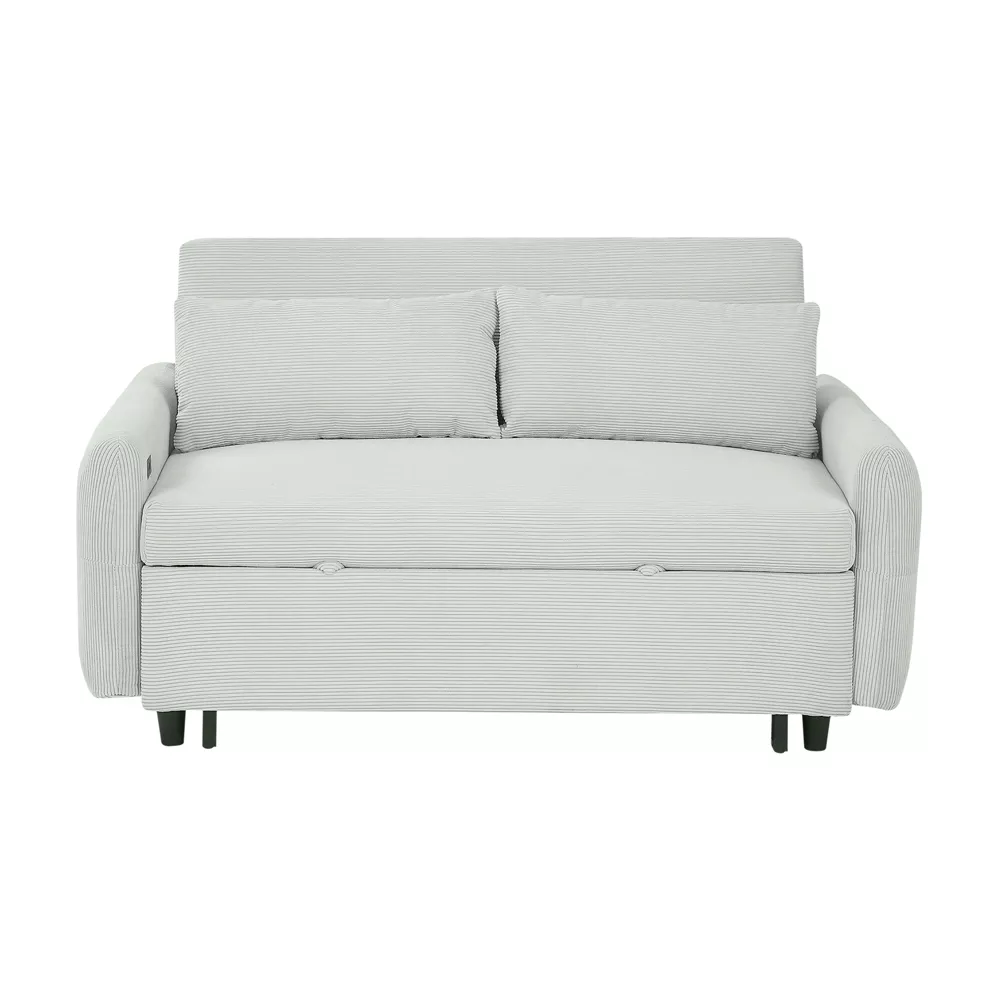
Dimensions: 32.3" h x 57.5" w x 36.6" d
This petite sofa bed from Target packs a surprising number of modern comforts into its small frame. Need to charge your phone? There’s a USB port for that. Want to tweak your posture? The backrest adjusts to three angles, so you can find your ideal lounge-to-sleep position without the usual fuss.
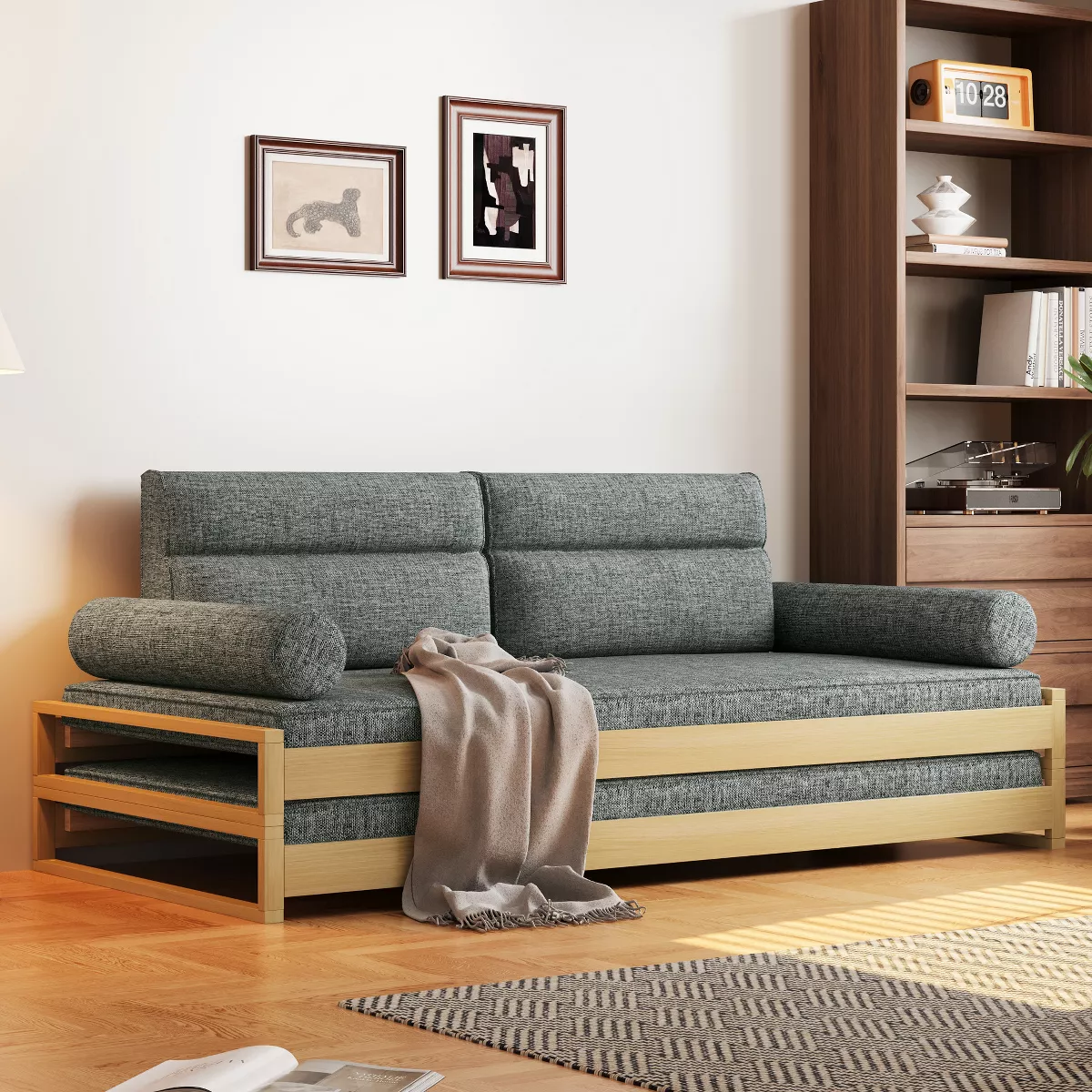
Dimensions: 42.1" h x 82.7" w x 38" d
Fans of mid-century modern design will appreciate this futon sleeper by Luck Live, which pairs a low-slung silhouette with a sturdy wooden frame for a high-design feel. The upholstery unzips for easy washing, and it’s earned a perfect five stars across 35 reviews (a rare feat in the sleeper-sofa universe).
4. Serena and Lily
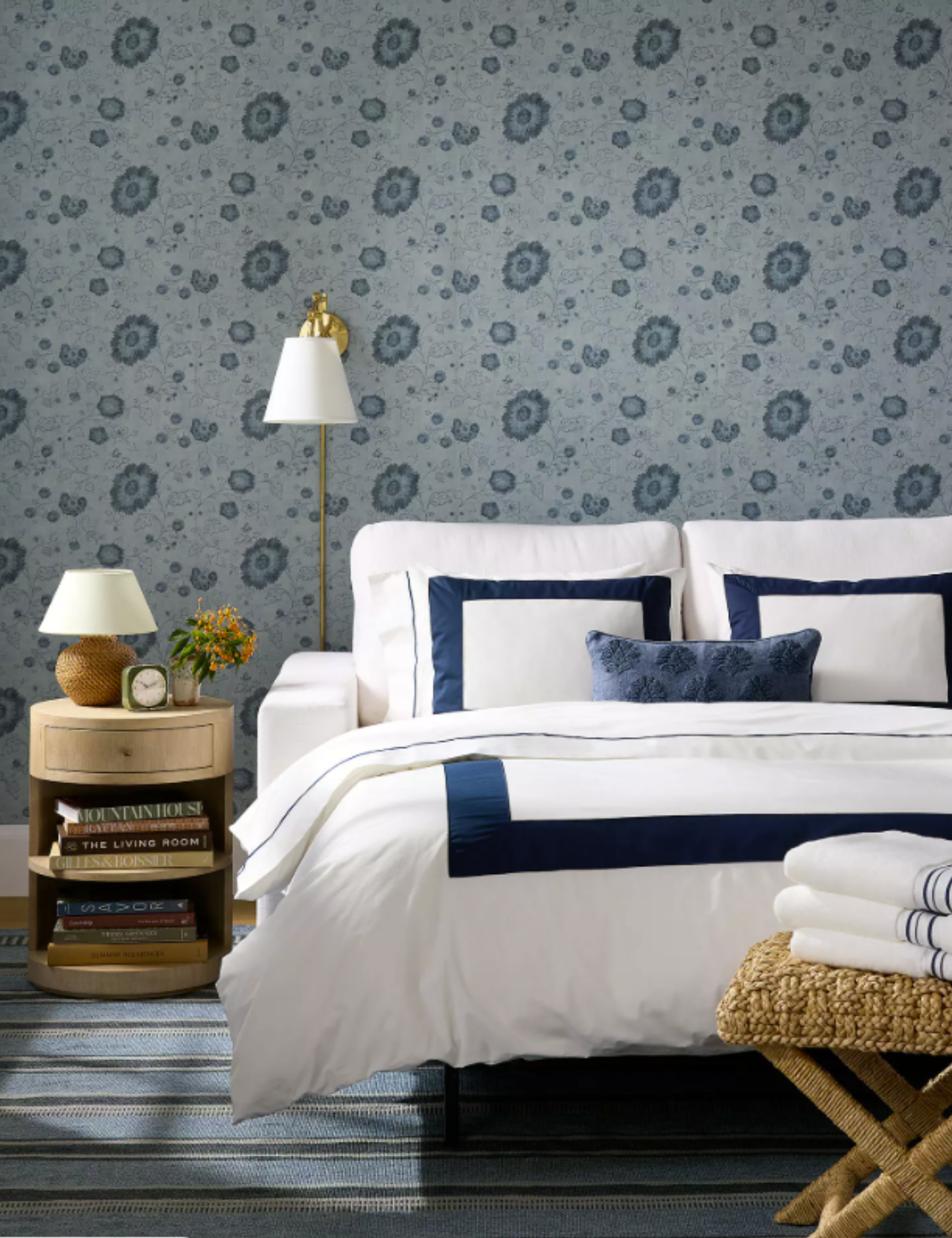
Best for: a designer look
Pricing: $$$-$$$$$
Serena & Lily sells some of the most expensive sleeper sofas on the market, but you really do get what you pay for in terms of style and quality, especially if you're looking for something that suits a coastal or traditional home.
They only have an offering of three ranges to choose (in different sizes and configurations) from but each piece is handcrafted in North Carolina and made from sustainably sourced materials. These deep-seated sofas can accommodate king-sized mattresses to accommodate multiple guests and taller sleepers. You can also add on the Primaloft Sleeper Sofa Mattress Pad, which has just launched and has been designed with 100% PrimaLoft Fiberfill for an extra layer of comfort.
Best of all, they're highly customizable: you can choose from hundreds of fabric finishes.
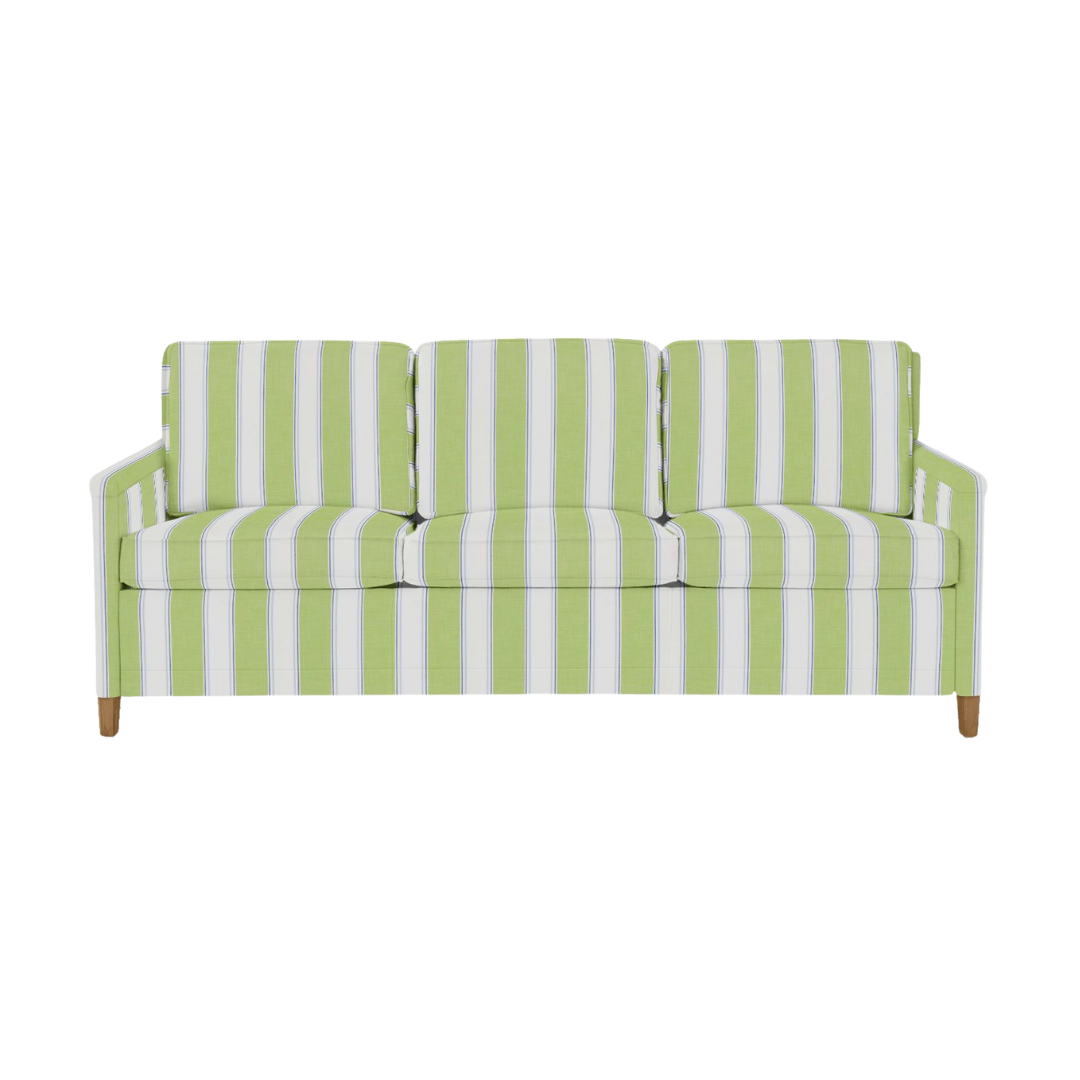
Dimensions: 85” w x 38” d x 37” h
A real timeless, traditional buy, the Spruce king-size sleeper sofa can be fashioned in a fabric of your choice and unfolded into a premium foam mattress. Crafted by hand from kiln-dried solid hardwood, this is a solid investment.
5. West Elm
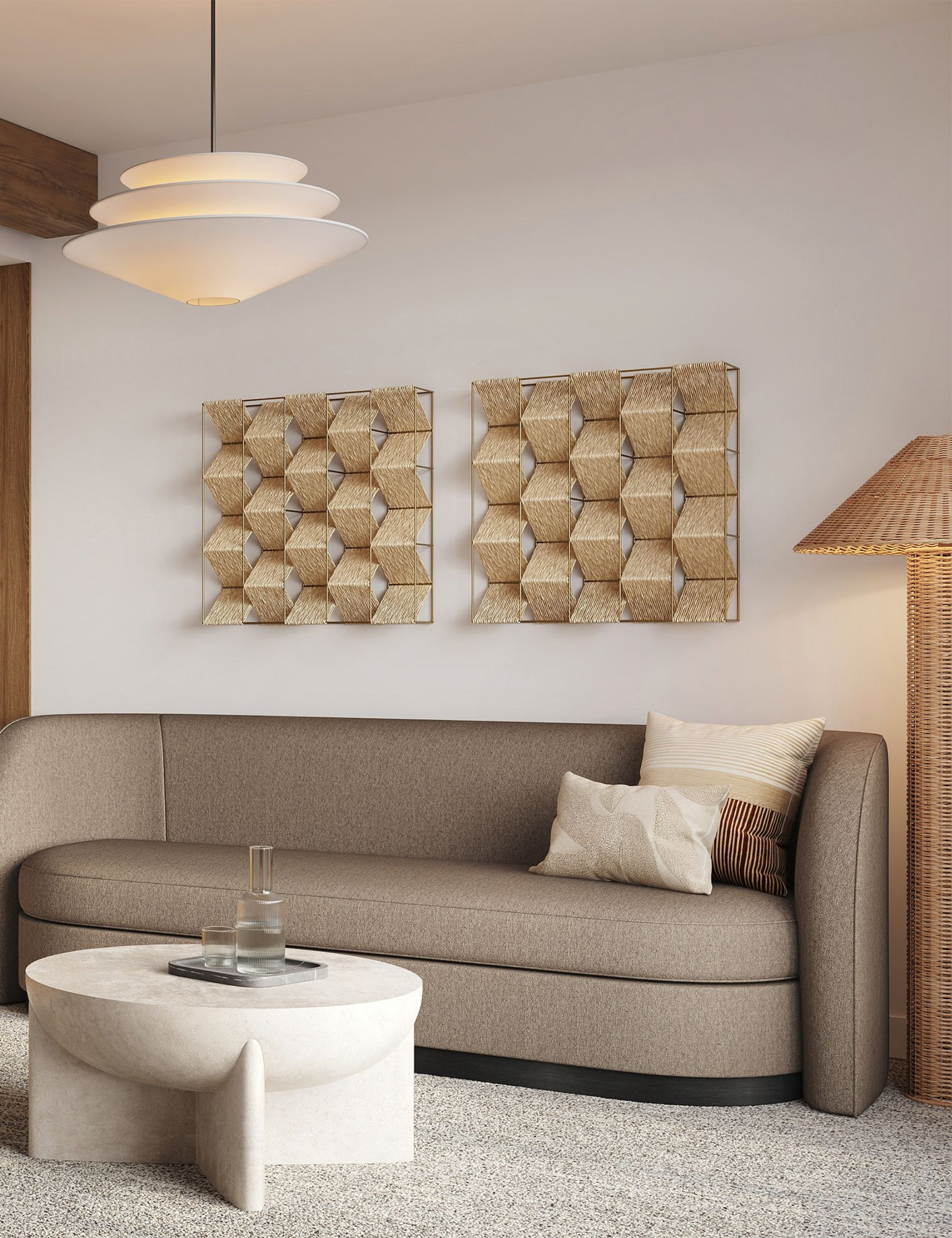
Best for: engineered comfort and handcrafted expertise
Pricing: $$-$$$
The best sleeper sofas are just as comfortable as couches as they are spare beds, making the sleeper sofa selection from West Elm suitable for daily as well as nightly use.
Most of West Elm's sofas' back cushions are wrapped in fiber, rather than foam, for greater give, and supported with high-gauge sinuous springs. These sofas are handcrafted and expertly joined to last for decades.
We have filtered their selection by bestsellers to show you the couches that are the most popular on West Elm for their style, comfort, and functionality. We also really like their 'how to measure for delivery' feature that helps you tell if the item actually fits into your home when it arrives.

Dimensions: 80" w x 38" d x 32" h
The Marin is a sofa by day, and a spacious sleeper by night, thanks to the contouring, memory foam-infused mattress. Assembled in the USA, the frames are hand-built with hand-finished upholstery so you can almost guarantee quality. This is a West Elm bestseller.
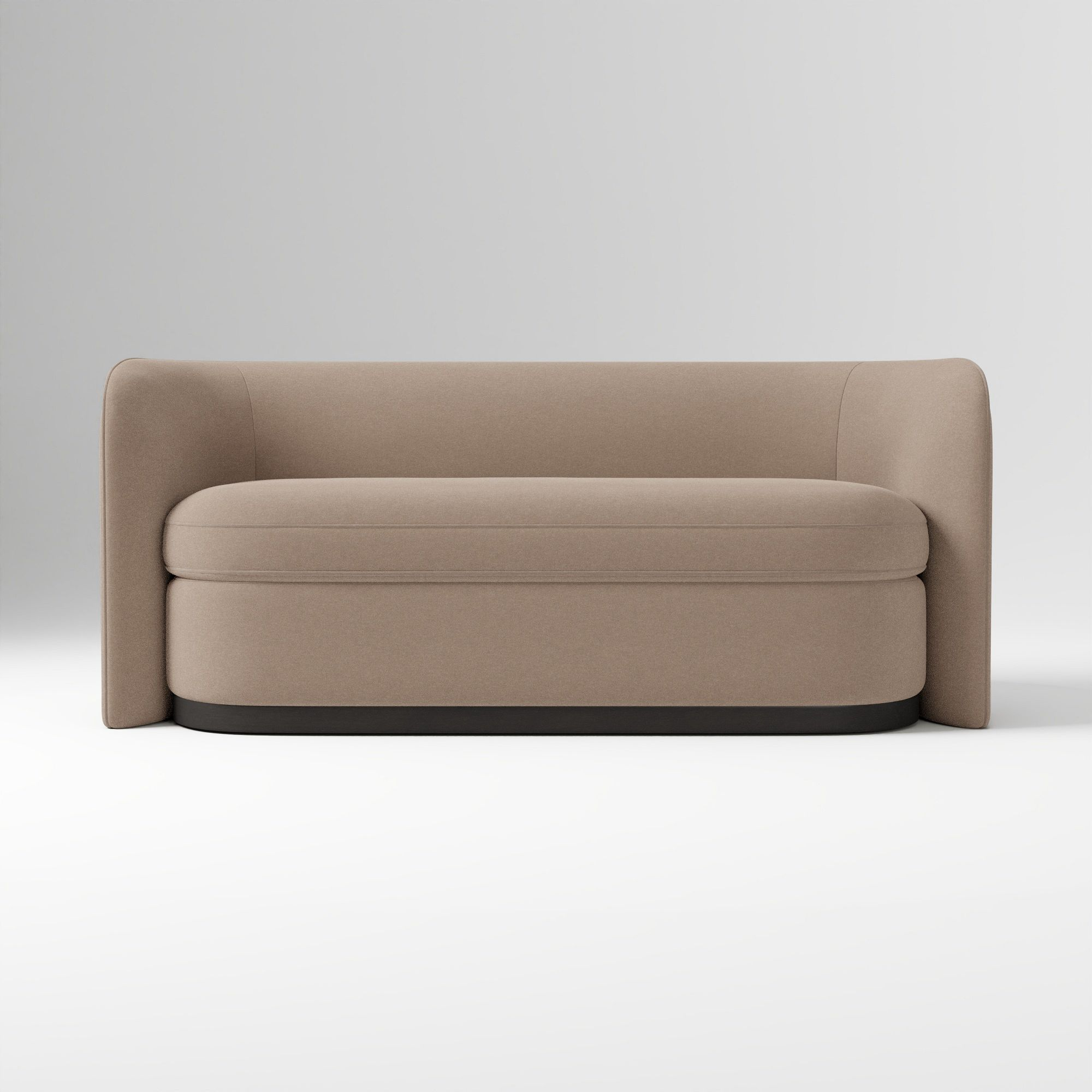
Dimensions: 73" w x 33.5" d x 33" h
If there were a contest for ‘best sleeper sofa in disguise,’ West Elm’s Teagan would be a frontrunner. Its contemporary curves read strictly sculptural rather than functional, befitting even the most design-forward living rooms. Take your pick between Twin, Queen, and King configurations.
6. Anthropologie
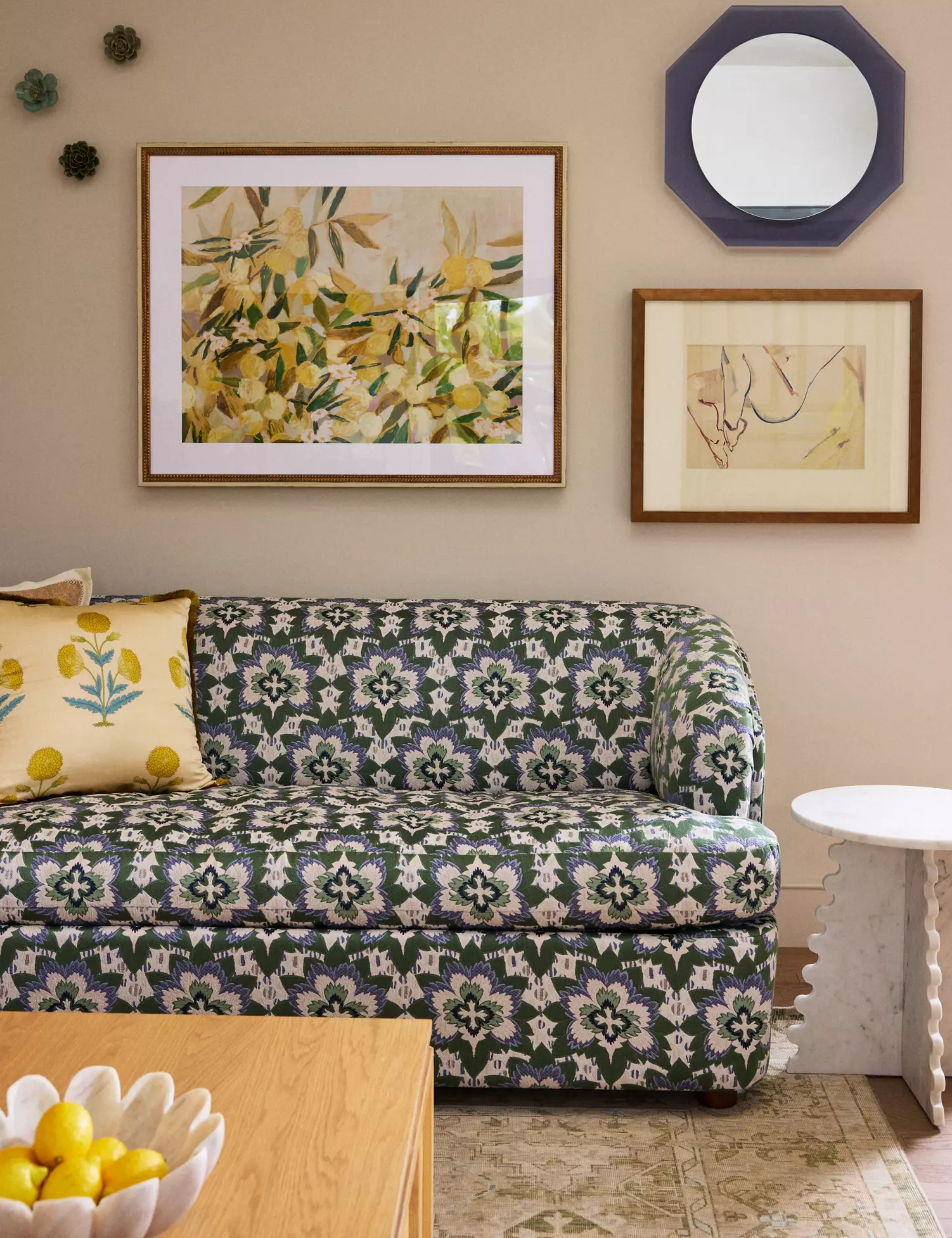
Best for: unique, design-led styles
Pricing: $$-$$$
At first glance, Anthropologie has a limited selection of sleeper sofas. But those that they do offer are a perfect balance of comfort and style for those looking to make a fashion statement with their sofa.
Each Anthropologie sleeper sofa comes in a range of fabric types and finishes. Most Anthropologie sleepers are made to order, though the Athena Sleeper Sofa is ready to ship with a wait time of 2-4 weeks. White glove delivery can also be chosen, starting at $149.
If you're looking to really swot up, Anthropologie offers a comfort guide for sofas and sectionals to help you find your perfect pick.
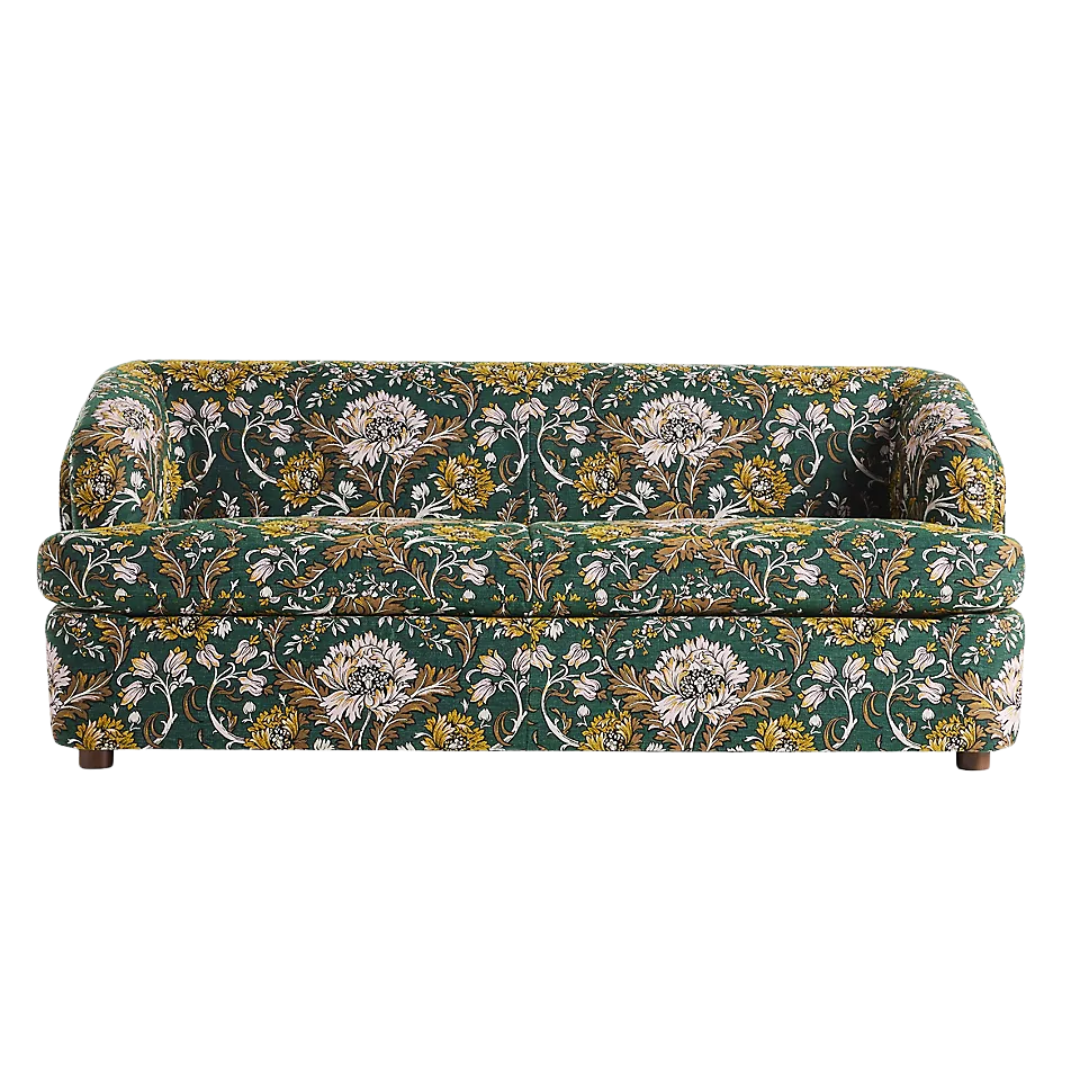
Dimensions: 33.75" h x 83.75" w x 37" d
Wrapped in an eye-catching jacquard, the Athena sleeper has a contemporary shape with gently sloped arms and a cushy, feather-filled seat. The pull-out bed makes a comfy queen-sized guest bed for your family and friends.

Dimensions: 32" h x 86" w x 39" d
Fully handcrafted to order, the Denver is a plush, laid-back couch perfect for living rooms. The white linen and charcoal options are in stock, but more custom colorways are made-to-order and can take a few months to make and deliver.
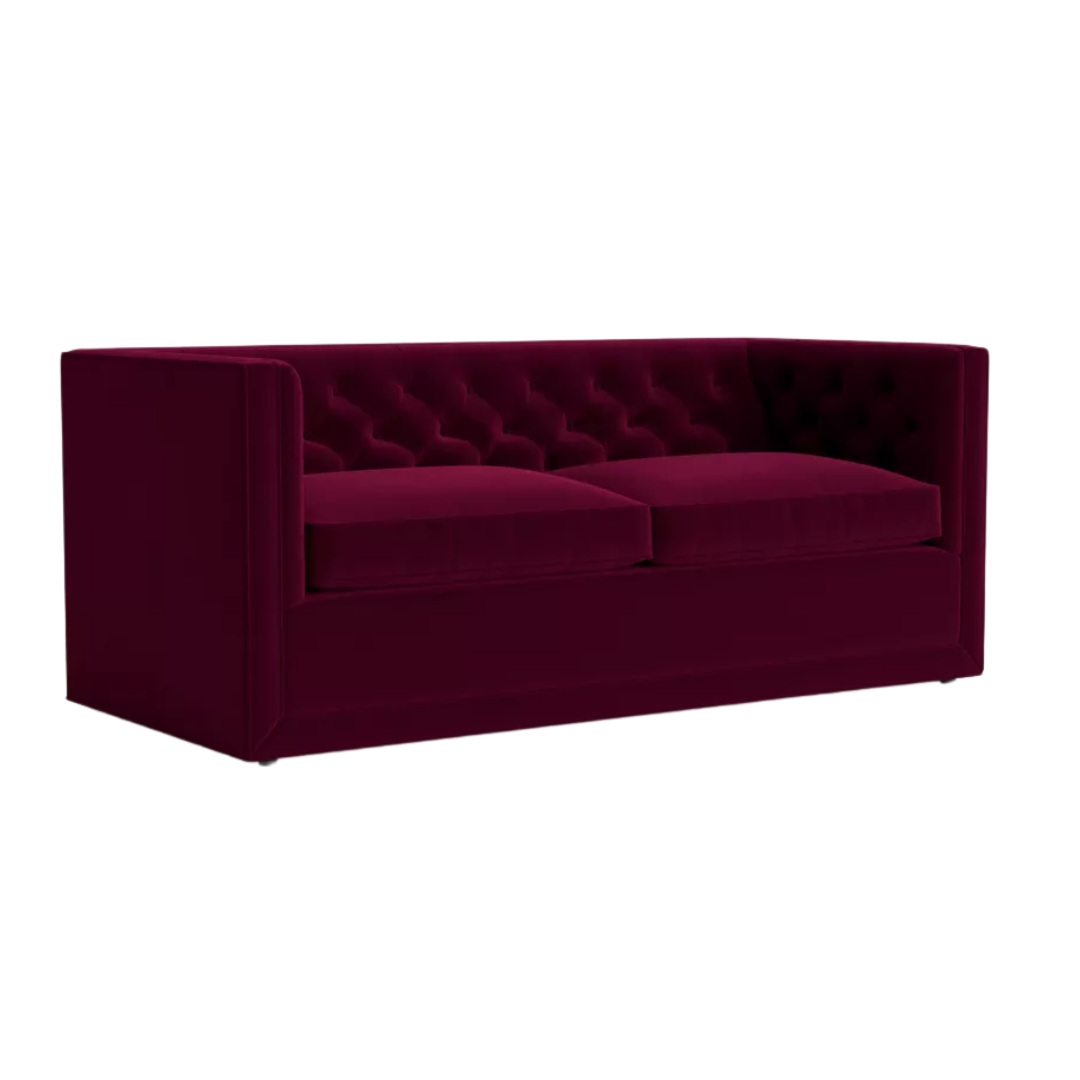
Dimensions: 31" h x 79" w x 38" d
Anthropologie, naturally, refuses to let the sleeper category stay humble. Button tufting adds a note of old-school polish, making it dignified enough for your busiest, most public-facing rooms. Upholstery options run the gamut from sherpa to Belgian linen to velvet, with a full slate of colorways to boot.
7. Walmart
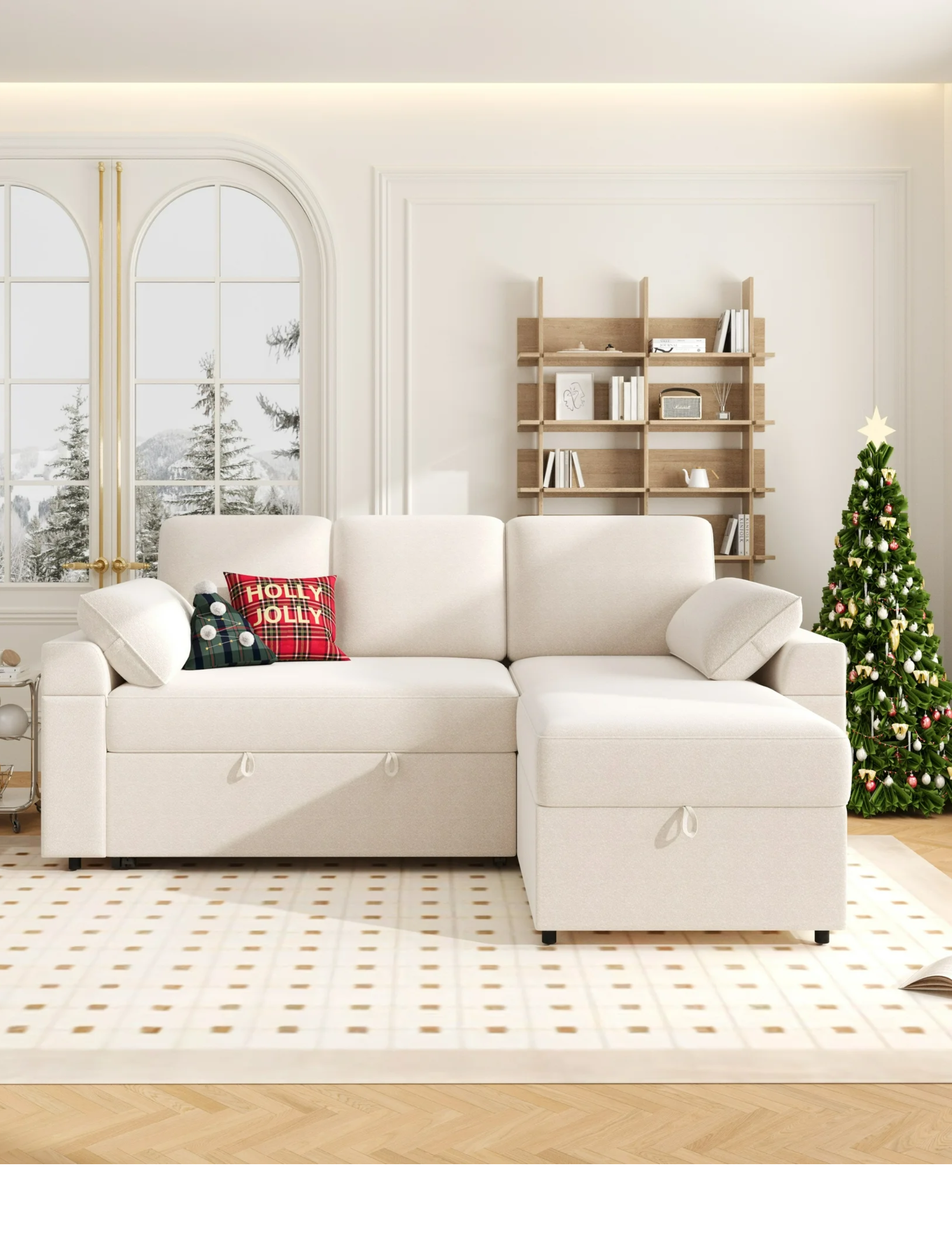
Best for: budget-friendly options
Pricing: $-$$
For less traditional options that are best suited for more infrequent use, Walmart is a great place to shop for sleeper sofas. You'll find futons, sectionals large enough to curl up on, and plenty of armchair sleepers that convert into a nap-worthy spot for single guests. If you're also looking for the best sleeper sofa for small spaces, Walmart is where I would recommend.
I'd start my search at Walmart if I were after something budget-friendly, for a rental or dorm room location, or something that wasn't going to be used every day – but perhaps you would want to spend a little more on a higher-end option if this was intended as your everyday sofa.
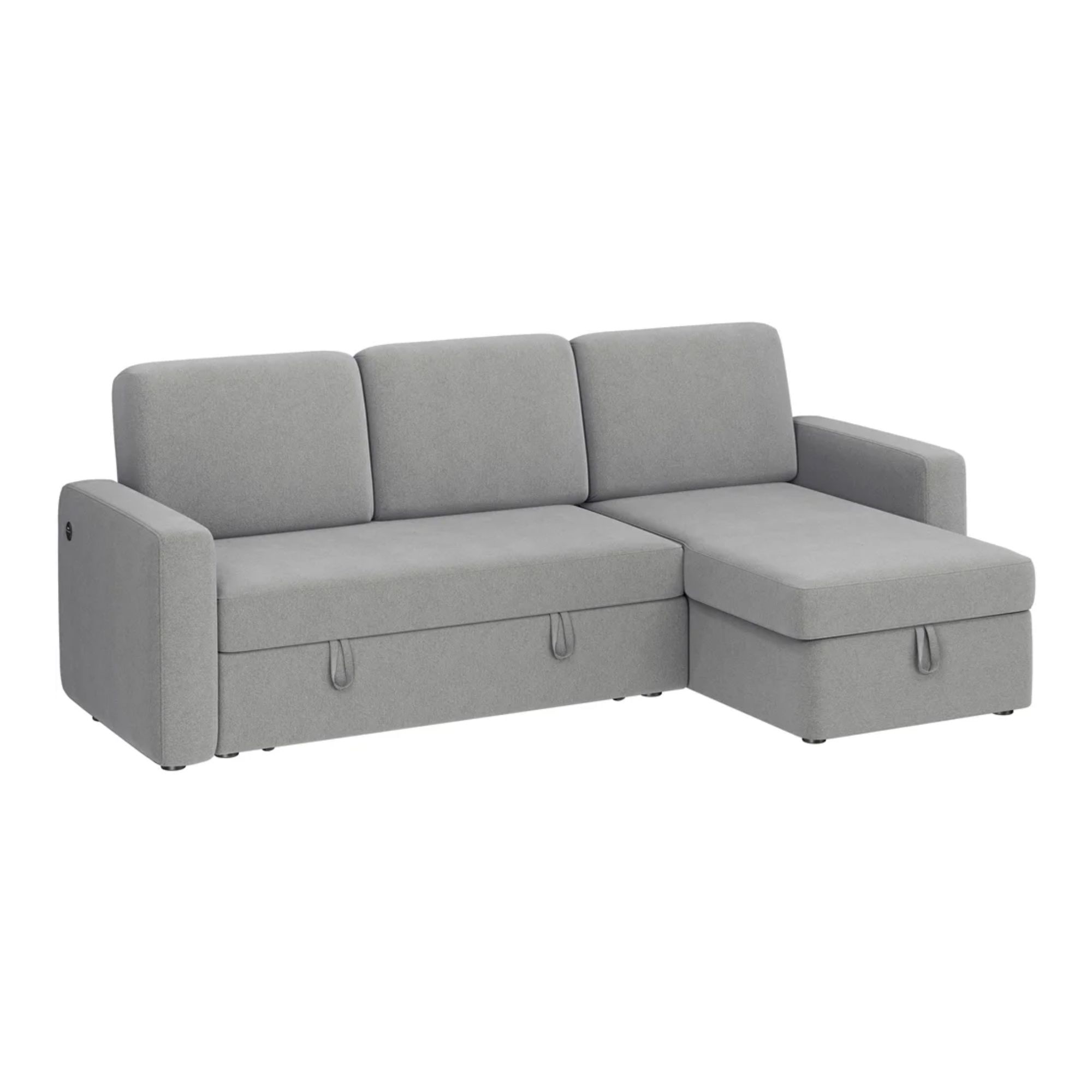
Dimensions: 33.5" h x 80.5" w x 51.5" d
This isn't a standard fold-out sofa bed as you know it. Instead, this sturdy foam-filled love seat can be pulled out using the trundle mechanism to create a double bed for two sleepers. Plus, the chaise can be placed on either the left or right, depending on your space.
How to Choose the Best Sleeper Sofa
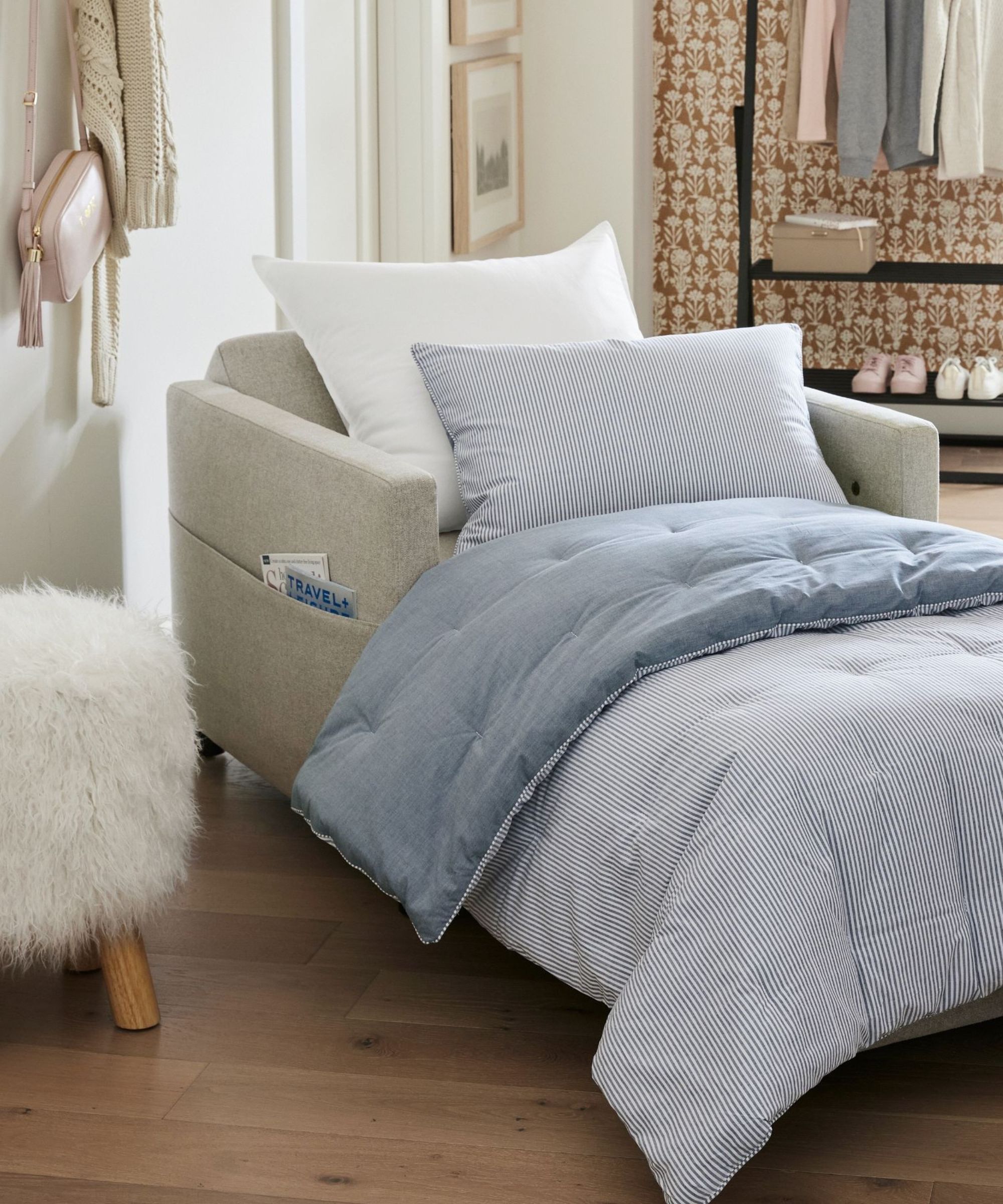
A sleeper sofa worth the name has to fit the bill both as a sofa and as a bed. In other words, it shouldn’t be a let-down as part of a living room, providing a place to sit and watch TV, read, and so on, nor should it feel like a compromise as a bed: the best mattress will allow a good night’s sleep.
'In terms of comfort, a sleeper sofa is a few steps above an air mattress, but it won’t feel as supportive as the best mattress for a guest room might,' explains our resident Sleep Editor Emilia Hitching, whose job it is to review and recommend the best sleep products on the market.
'As a kid, I slept on a sleeper sofa for six months while my house got renovated. I loved pulling out my bed from the couch at the end of every day: it felt like a never-ending sleepover. My parents loved it, too: our sleeper sofa was quick to fold and convenient to store.'
'Don't get me wrong: even the best sleeper sofa is no substitute for a real bed. Your standard sleeper sofa features a thinner, less supportive mattress for the sake of storage space. I wouldn't recommend sleeping on one of these sofas for more than a night or two at a time: otherwise, you're putting yourself at risk of aches and pains.'
Setting up the bed at night and putting it away again in the morning should also be easy. There are a number of factors you’ll need to consider to get the right model of sleeper sofa for your room from size to mattress type and all you need to know is below.
Type & Style
A sleeper sofa is literally just a couch designed with a built-in mattress and frame with legs, which allows you to convert it into a bed for overnight guests or for occasional use.
Typically, a clever mechanism will allow the mattress to be pulled out of a sleeper sofa, and spending more should get you a better mechanism that makes putting the bed up stress-free. For even easier opening, there are also designs with power, so you can use a remote to convert your sleeper sofa to a bed in double-quick time. Or you can opt for a simple futon or trundle styles that just fold back or pull out.
You can choose between conventional sofa shapes, chaises, armchairs, love seats, and even sectionals when you’re buying a sleeper sofa. The size, shape, and style will all depend on your budget and the quality of the retailer you choose, so it is important to ensure you've found the best places to buy a sleeper sofa.
- Traditional pull-out: these have a bed frame that pulls-out from under the seat cushions
- Fold-out: the mattress will fold out from the seat and sit on a frame
- Futon: traditionally a floor mattress that folds up into a sofa
- Trundle: a platform bed or couch with an additional slide-out bed
- Click-clack: these use a simple "click" and "clack" mechanism to fold down to a bed
- Sectional sleeper sofas: larger sofas with a pull-out bed function
Mattress Types
Shop for a sleeper sofa, and you’ll find that you can exercise your preference for mattress type in a way that didn’t used to be the case. You can opt for the traditional innerspring mattress, or choose the firmer feel of latex, for example.
Fans of memory foam for their beds can pick a sleeper sofa with a mattress in the same material, or go for a gel version that can be preferable if you find memory foam too warm.
'A click-clack sofa bed, or an armless sleeper, might do for one night, but it’s insufficiently supportive for longer stays. You need to find a sleeper sofa with a real mattress inside,' Emilia suggests. 'Which mattress type is best for you depends on your sleep style. Bear in mind that a sleeper sofa mattress is likely to be a lot thinner than a free-standing mattress: we’re talking about five or six inches at most.'
- Memory foam: great pressure relief and motion isolation (good for couples), but tends to trap heat.
- Gel memory foam: the same cushioning comfort and pressure relief, without heat retention.
- Innerspring: filled with supportive steel coils and topped with wool or cotton; it won’t feel as comfortable for sitting or sleeping.
Materials & Construction
First of all, look for a solid hardwood frame, which should prove durable. Consider seat cushions, too. You may prefer the support and durability of high-density foam, or the combination of foam plus feathers or foam plus fiber for a little more give. In higher-end sleeper sofas, you can also find down and feathers combined with other materials. If you go for the latter, be prepared for regular cushion fluffing duties.
Pick upholstery that suits your lifestyle for a sleeper sofa that lasts and stays looking its best. Look for fabric with a high thread counts to stand up to heavy wear and to keep stains at bay in a home with kids and companion animals.
'As you consider the look and feel of a fabric, think about its durability. Something like leather is able to withstand wear and stains much better than, say, linen. Ideally, you want a sofa that’s easy on the eyes and easy to clean,' adds Emilia.
'Inspect the base of your sleeper sofa. You want something solid and supportive, ideally made from wood, with screws or dovetail joints for strength. Avoid plywood and particleboard, which are less capable of withstanding weight.'
Mattress Size
Whether one or two people will sleep on the sleeper sofa is important. ‘If you’re sharing a bed with another person, it’s important to select a mattress size that offers enough width for both of you to sleep comfortably,’ says Jin Chon, co-founder of Coop Home Goods. ‘As a general rule, each sleeper should have around 30 inches of space to move around in.’
Bear in mind that if a sleeper sofa is just used for one night at a time, then allowing this much space isn’t as crucial. However, if it’s used for extended periods, following this guideline will create comfort.
Thinking smaller? ‘For single sleepers who want more room than a twin-size mattress provides, a full-size mattress can be a good choice,’ says Jin. ‘However, it may not provide enough space for two people to sleep comfortably and isn’t usually recommended for couples.’ In this case, sizing up to a queen or bigger would be preferable for two due to the restricted width per person of a full.
‘Ultimately, the right mattress size for you will depend on your individual preferences and requirements,’ says Jin. ‘By considering factors like room size, budget, and sleeping habits, you can choose a mattress that offers the comfort and support you need for a restful night's sleep.’
Sleeper sofas also offer a variety of mattress sizes. Some replicate standard mattress dimensions, given below, or you may need to compare the slightly different mattress dimensions of a particular sleeper sofa to a standard mattress size to assess it.
- Twin 38 x 75 inches
- Full 54 x 75 inches
- Queen 60 x 80 inches
- King 76 x 80 inches
Space
'Before you buy a sleeper sofa, consider the shape and size of the space,' Emilia advises. 'If you’re working with awkward angles and tight corners, you might opt for an L-shaped sectional sofa. If you’re trying to fit a sleeper sofa into a very small space, you might need to go for a chair bed or a twin-sized sofa.'
The space available in the room, in general, is, of course, a primary consideration when buying a sofa. Make sure its proportions don’t impede circulation through the space, and follow the principles of sofa scaling to ensure your piece of furniture has the correct proportions for the room.
'Ideally, you want to find a room with enough space for a queen-size sleeper sofa, so you can comfortably accommodate two people. You’re looking for something around 84 inches wide and 90 inches long: consult my mattress size chart if you’re unsure.'
It is worth noting that, depending on the room’s dimensions, other furniture might need to be moved temporarily, but these should be light pieces that can be temporarily placed in a corner or elsewhere. And if you really value your guests' overnight experience, you'll want to be sure you have enough space for a little side table for a lamp and glass of water.
FAQs
How much does a good sleeper sofa cost?
This is obviously a really subjective question. I have listed sleeper sofas in this edit that range from just under $400 up to around $8,000 and given you an idea of the pros and cons of each price bracket or retailer.
Of course, a "good" sleeper sofa is going to cost you a little more, so it is worth really digesting all the info above and seeing just how many key features you can get for your budget: e.g. memory foam mattress, sectional configuration, or custom fabric options. I should think that in order to get a really decent sleeper sofa that will last you for years, you're going to need to spend somewhere between $1,000-$2,000.
With that said, it is also important to note that the best sleeper sofa is the one that best suits your needs. You should consider whether you want to use this sofa primarily for sitting or sleeping and shop accordingly. The best sofas have solid wood frames, soft and squishy seat cushions, and come in a wide range of colors. Meanwhile, the best beds come with the best mattresses that support you while you sleep. And you're looking for a combo of the two within your budget.
Can you use a sleeper sofa as your main sofa?
This is the big question. The answer is absolutely yes, but you need to prioritize a few things.
Many modern sleeper sofas are designed to be as comfortable and stylish as a standard sofa, but it is important that you choose a model with a sturdy frame and plenty of plush cushioning to stop you from feeling the mattress mechanisms underneath, which is a pet peeve of sofa bed owners.
Of course, if you shop around for something that perfectly matches your living room, is built to last, and enviably comfortable, then there is no reason to not use a sleeper sofa as your main sofa. In fact, it is a great space-saving hack.
What is the best sleeper sofa mattress?
Which mattress material is best all comes down to who's sleeping on it.
The best mattresses for side sleepers are soft and supportive, designed to alleviate pressure from your joints. Most often, these are memory foam mattresses. Front sleepers need a firmer surface to maintain the natural alignment of their spine. Old-school innersprings tend to be firmer than modern memory-foam mattresses.
If you want to host multiple guests, all of whom have different sleep needs, then your best bet is a medium-firm mattress, which should suit most sleep styles.
Sleeper sofas have come on leaps and bounds in the last few years, with designers and brands putting much more effort into the construction, design, and comfort of these adaptable pieces to bring you something that looks and feels like a really solid investment piece.
If you're still unsure about your love or hate for sleeper sofas, I'd recommend having a read up on how to make a sleeper sofa look more expensive for some real design-led tips on styling your sofa bed to create the most luxurious guest space that doesn't compromise your every day aesthetic.
Design expertise in your inbox – from inspiring decorating ideas and beautiful celebrity homes to practical gardening advice and shopping round-ups.

Charlotte is the style and trends editor at Homes and Gardens and has been with the team since Christmas 2023. Following a 5 year career in Fashion, she has worked at many women's glossy magazines including Grazia, Stylist, and Hello!, and as Interiors Editor for British heritage department store Liberty. Her role at H&G fuses her love of style with her passion for interior design, and she is currently undergoing her second home renovation - you can follow her journey over on @olbyhome
- Emilia HitchingSleep Editor


